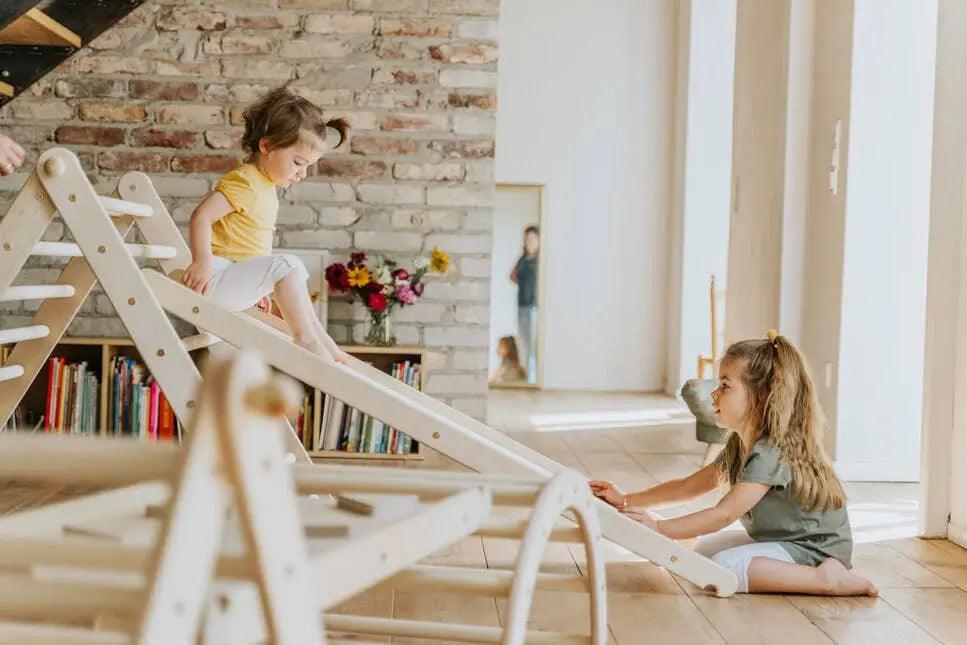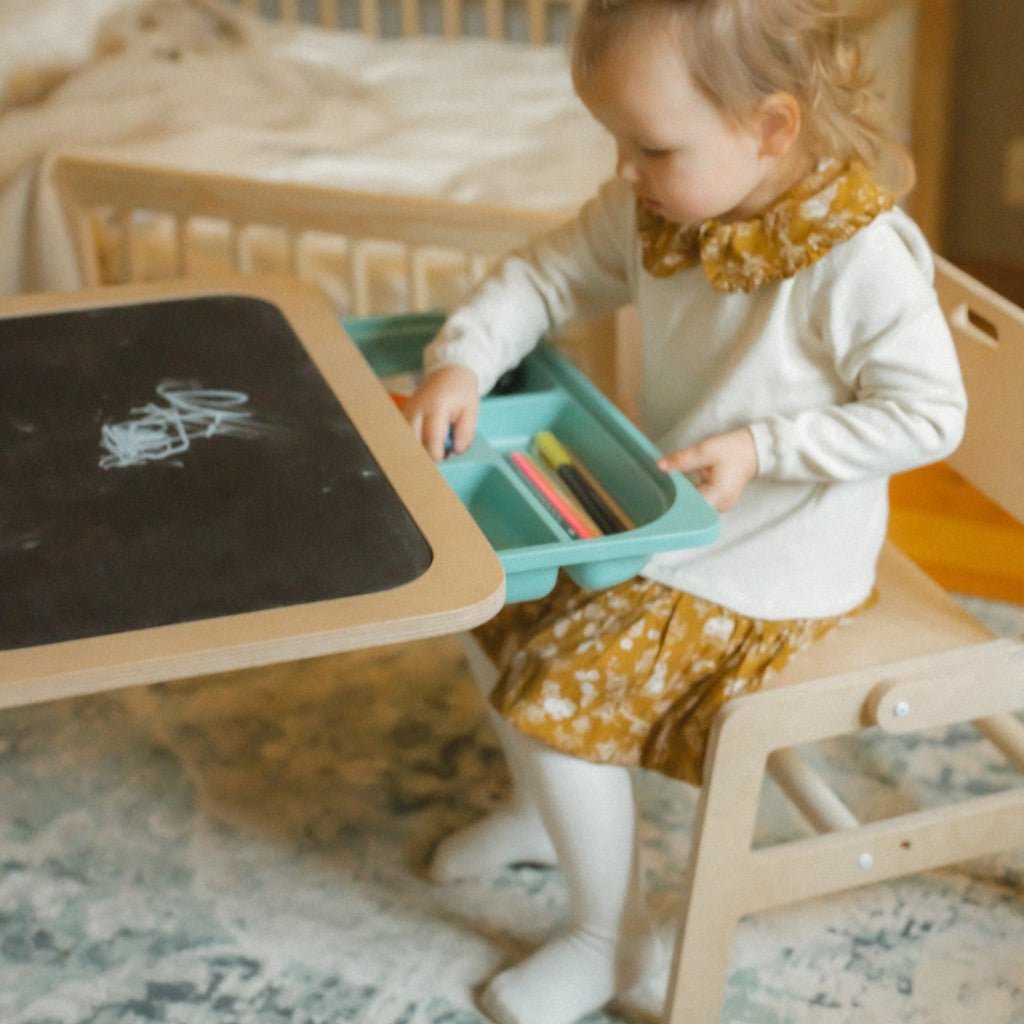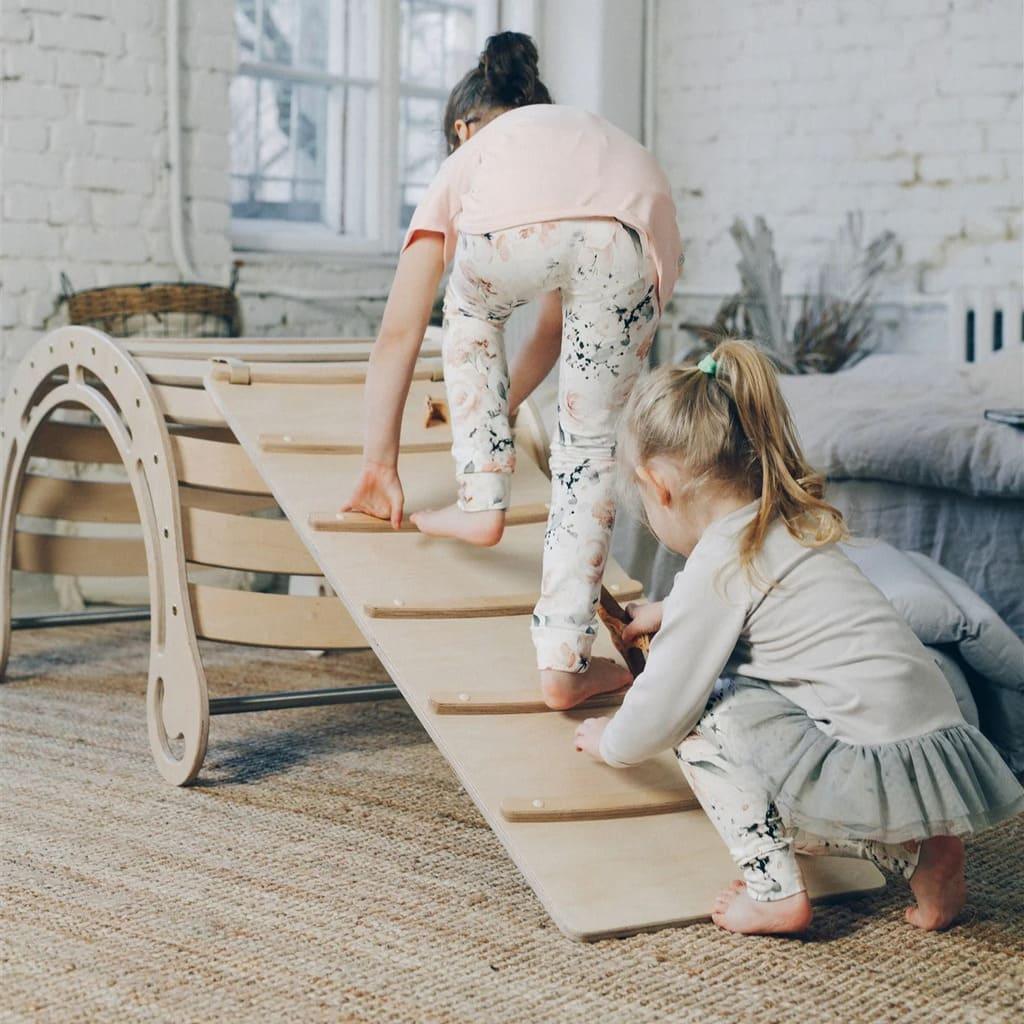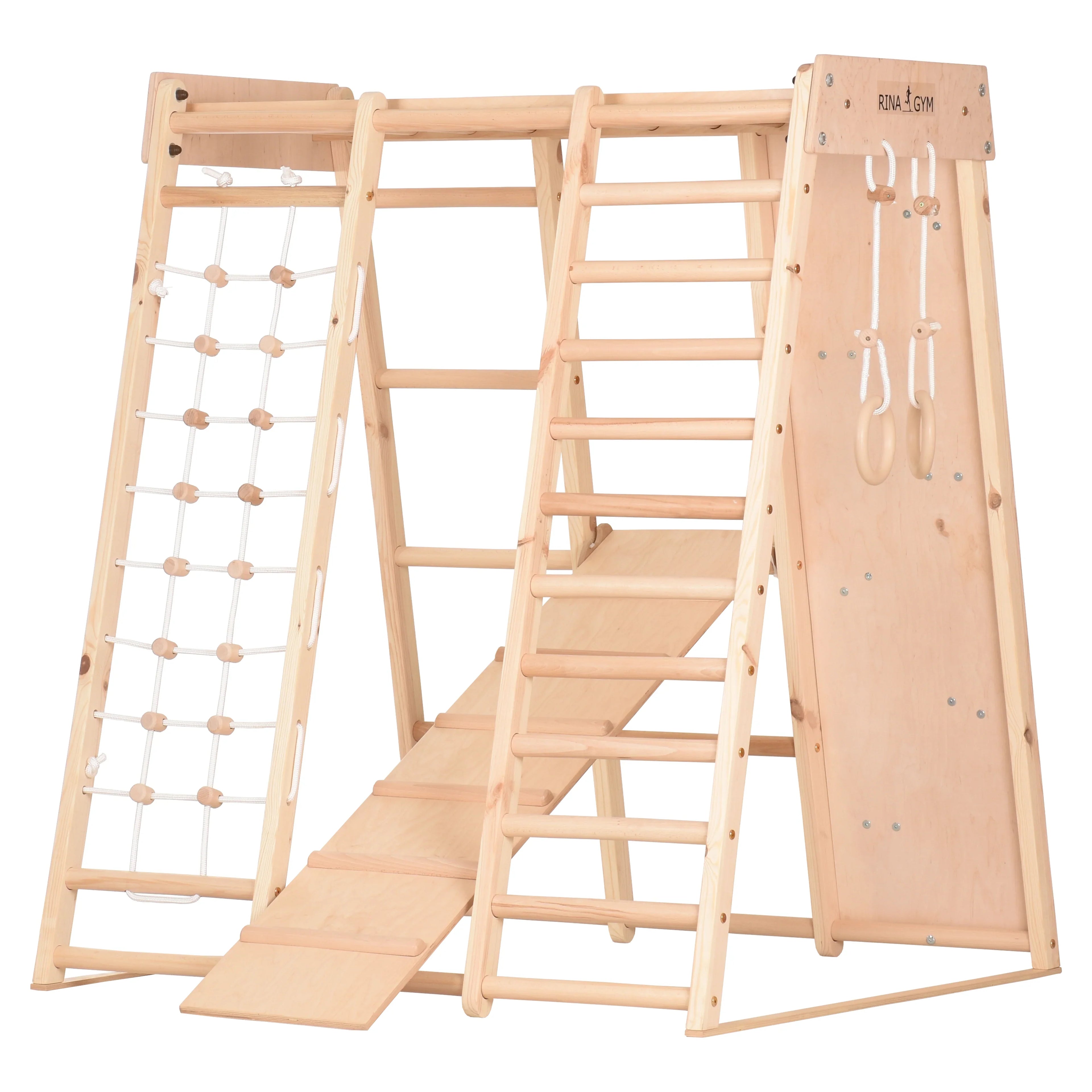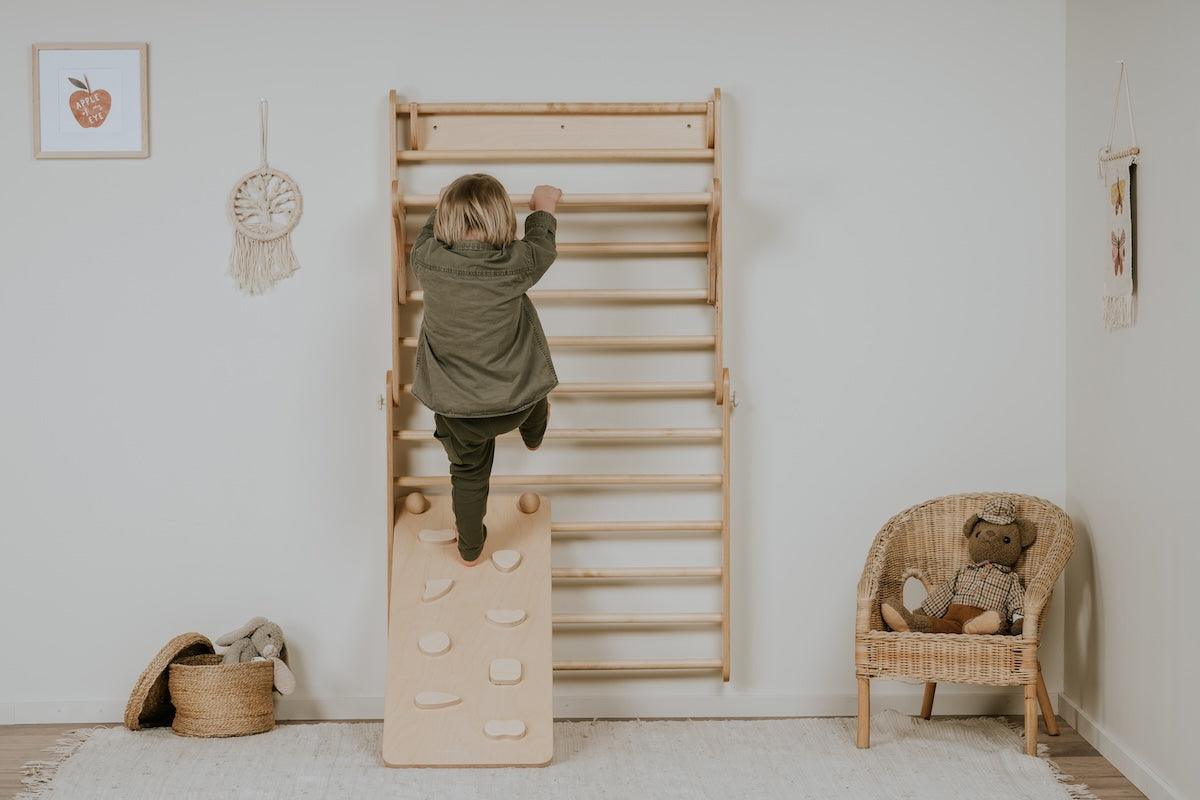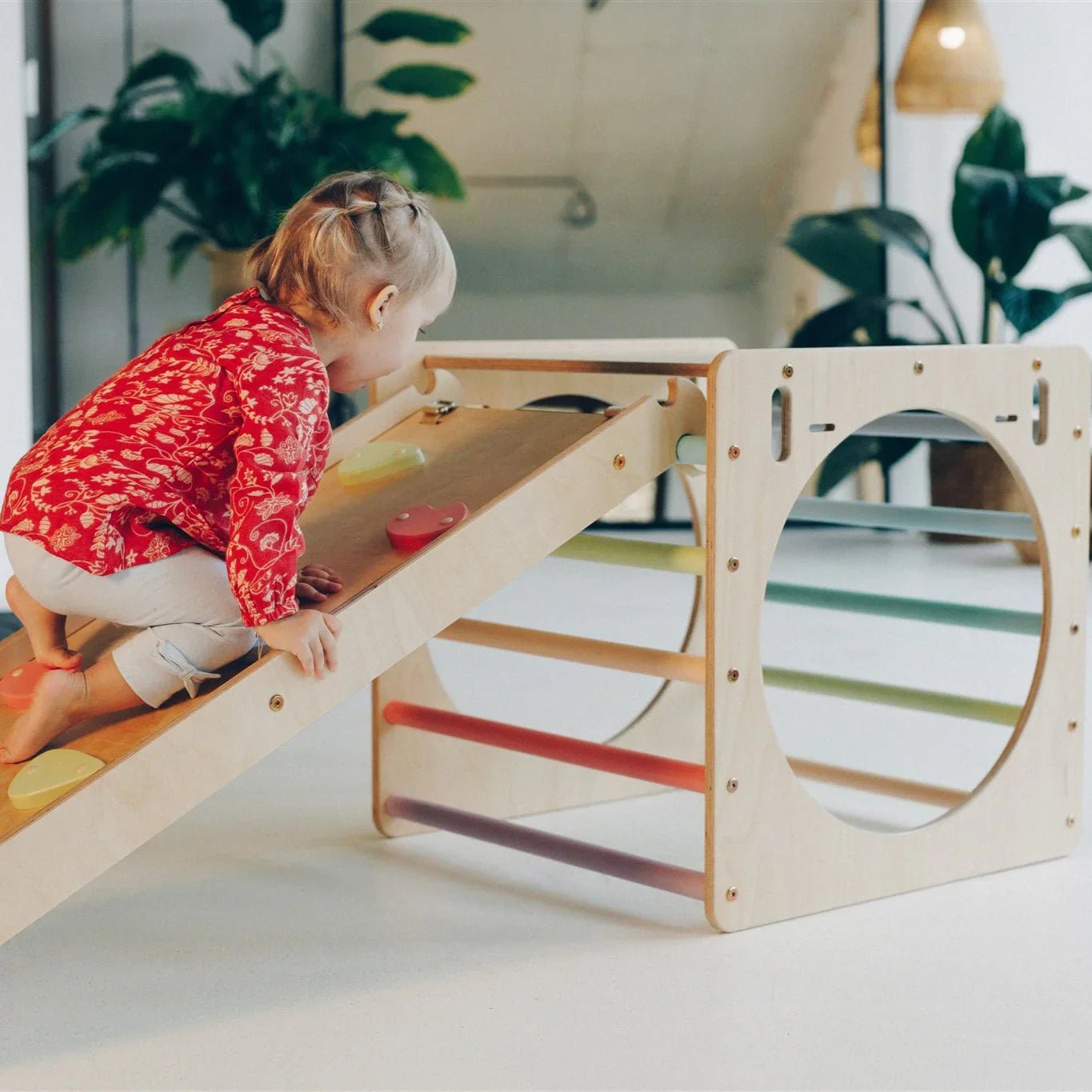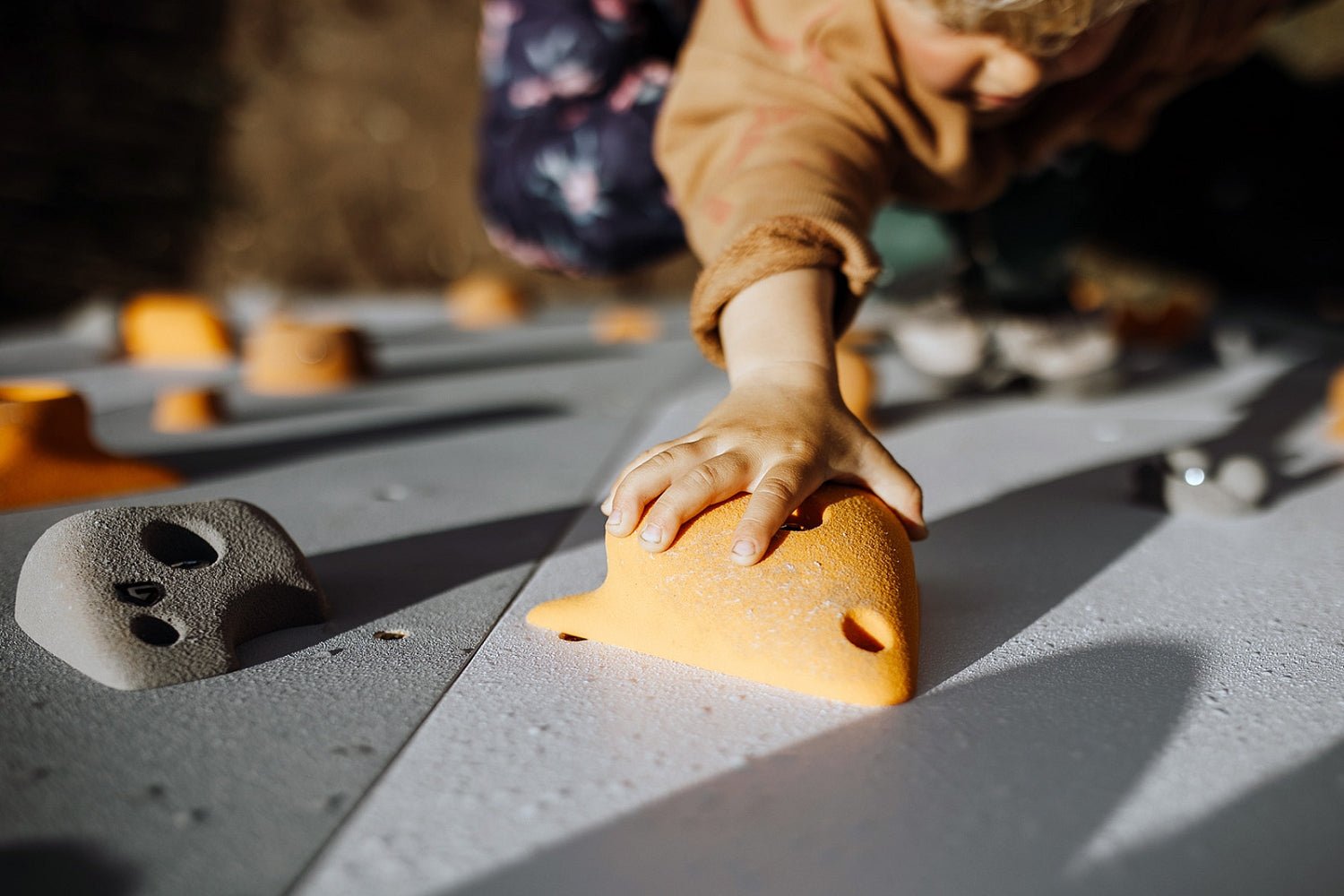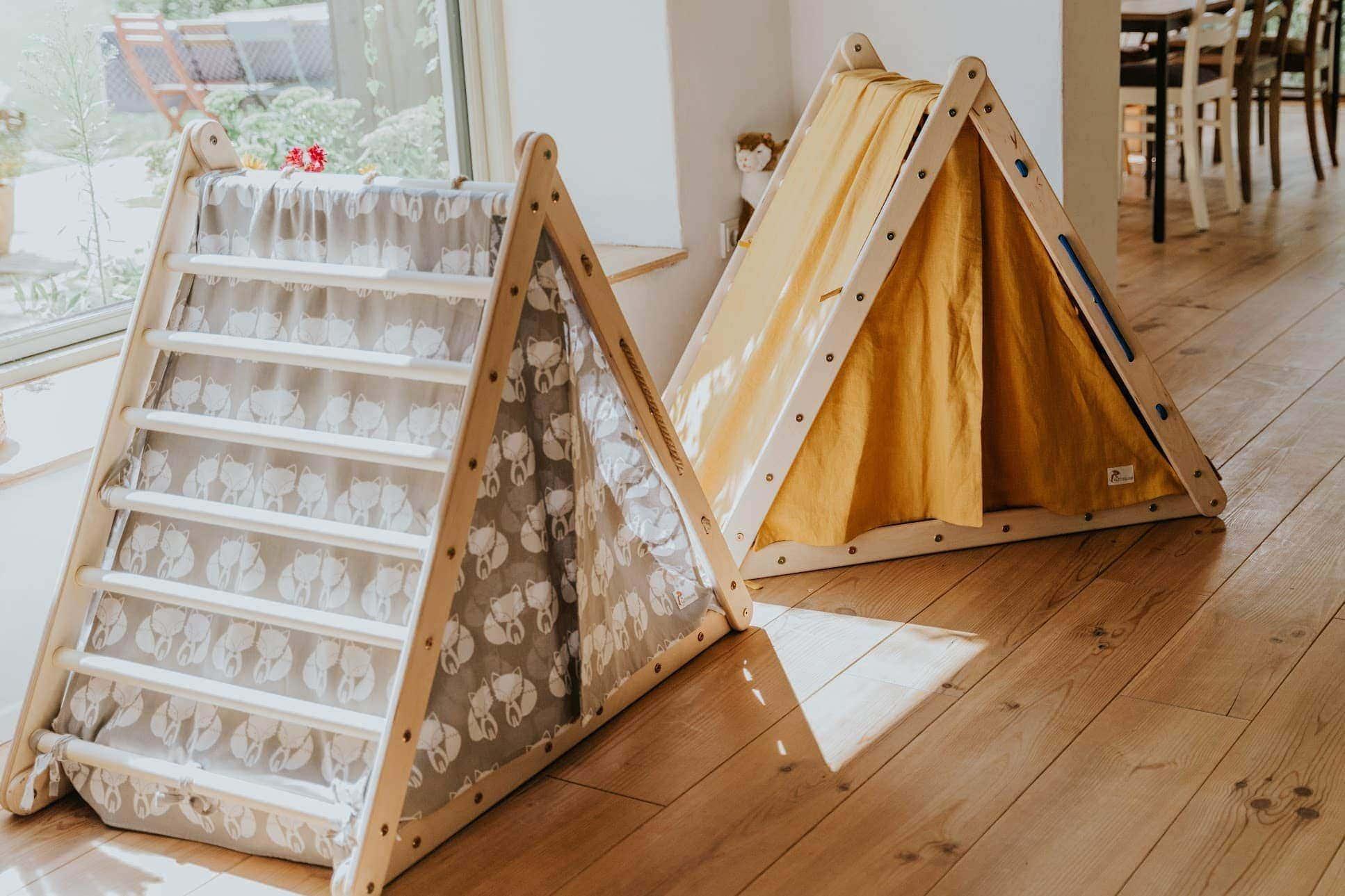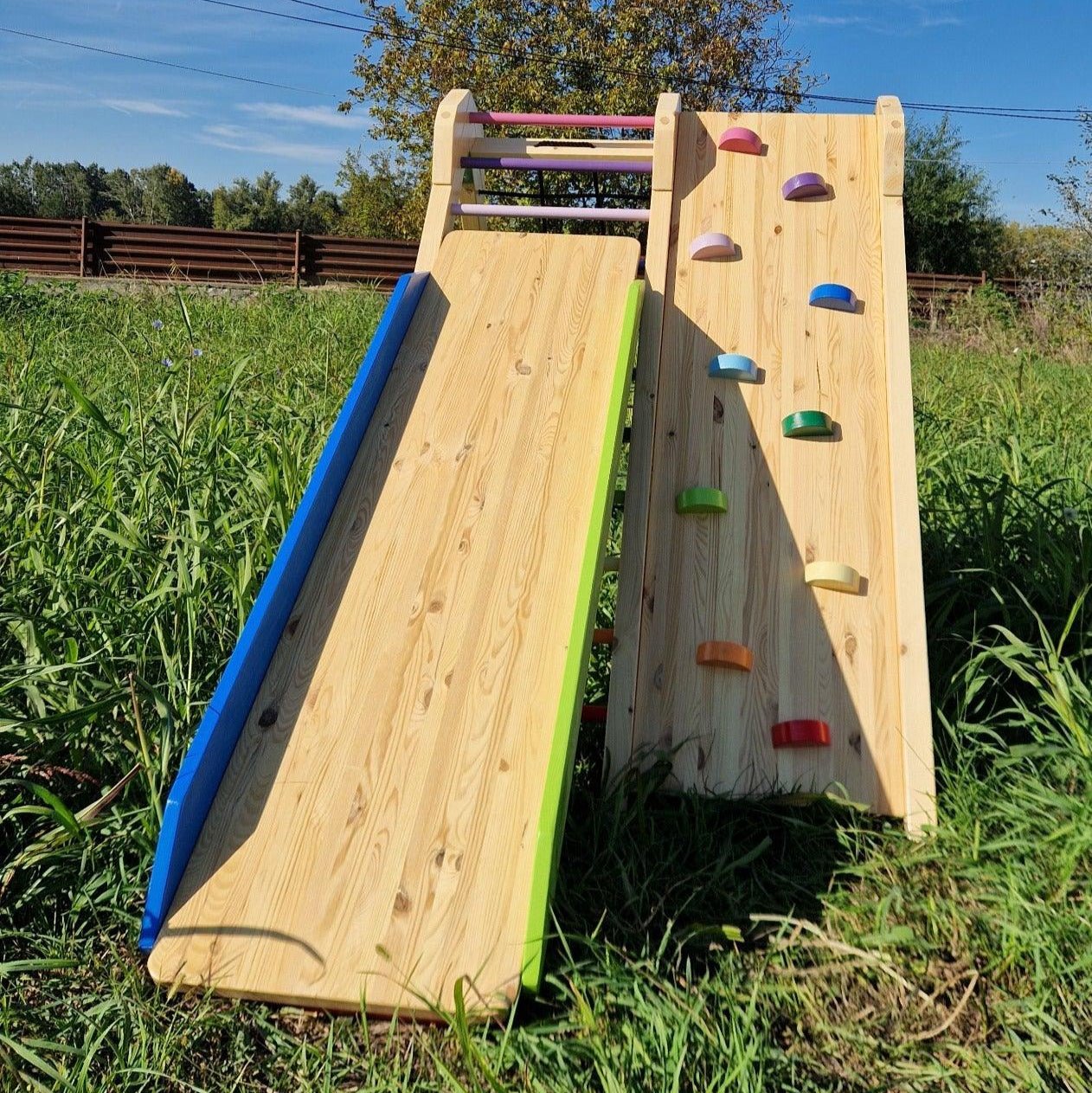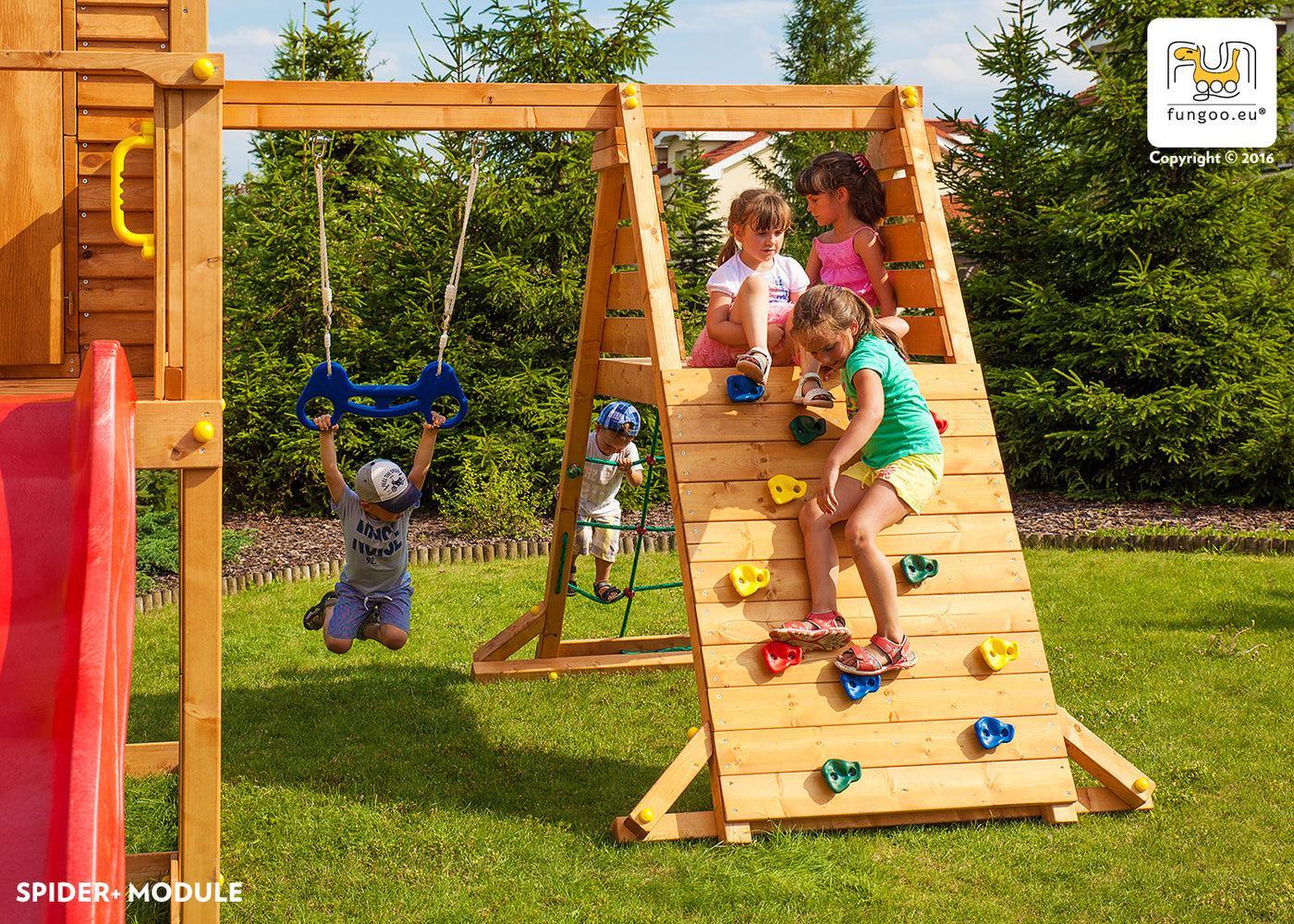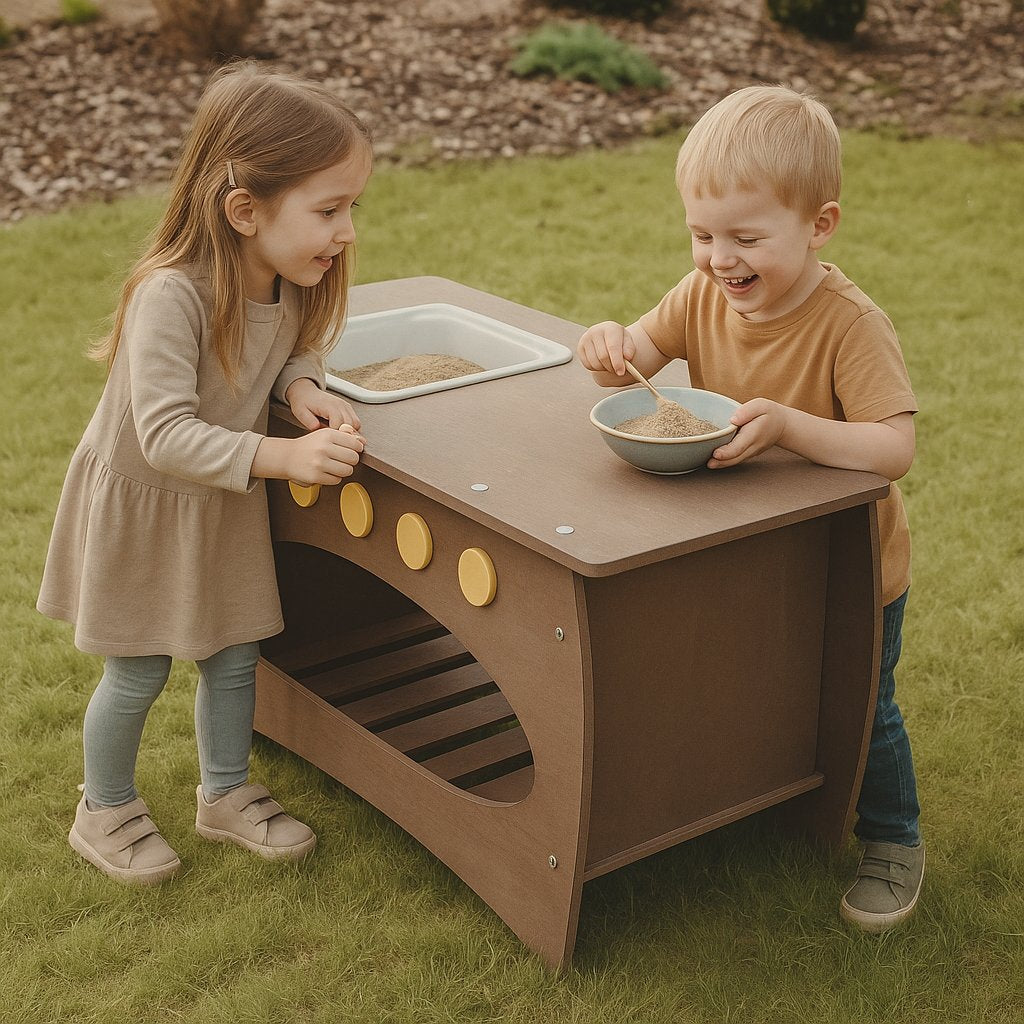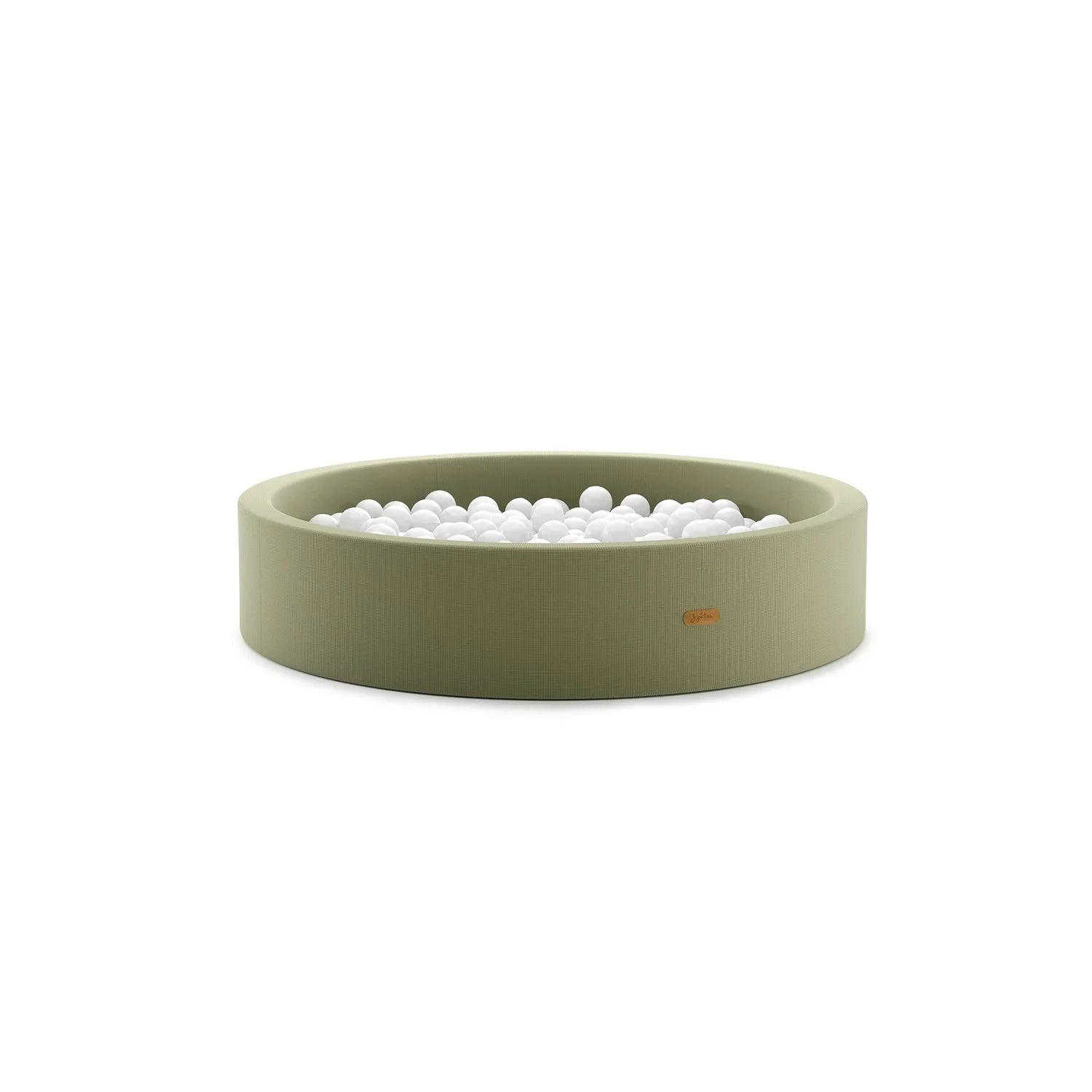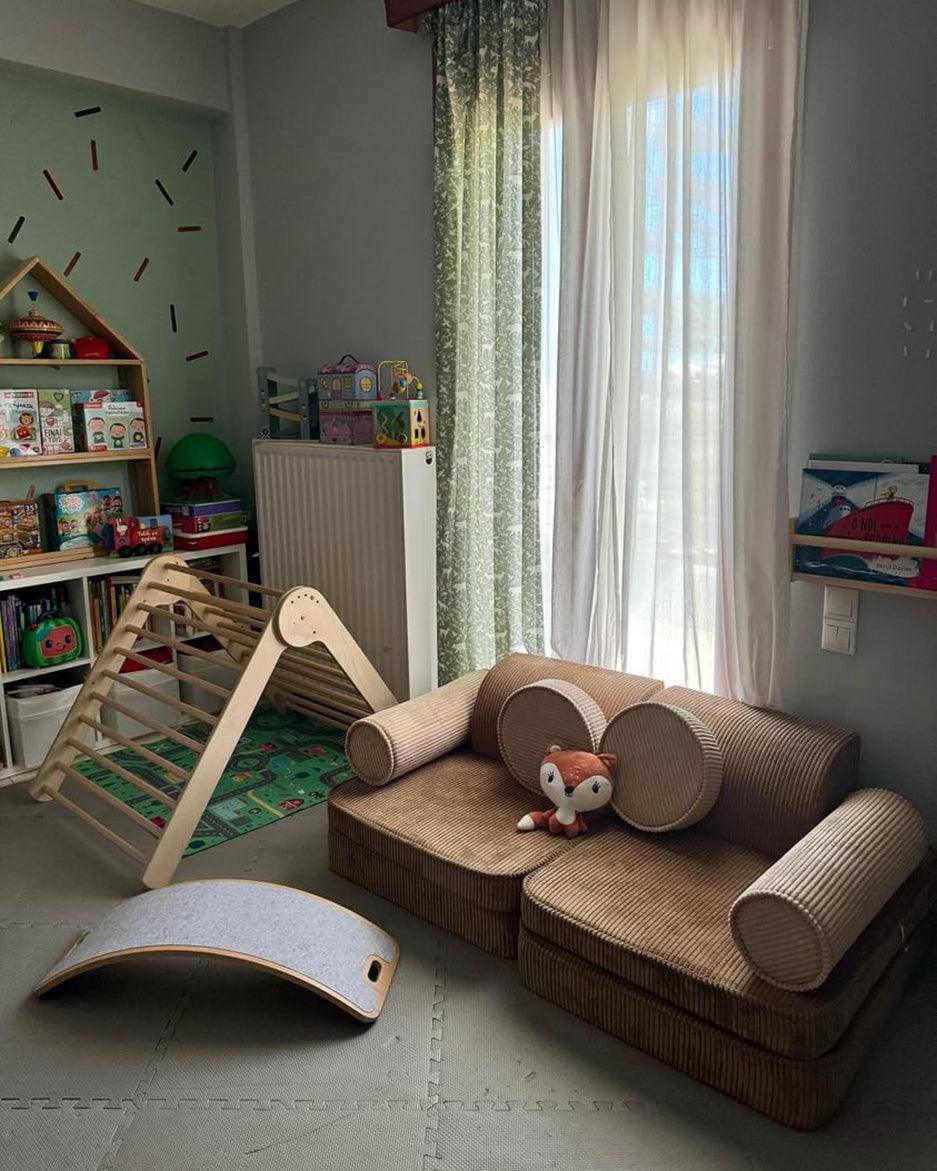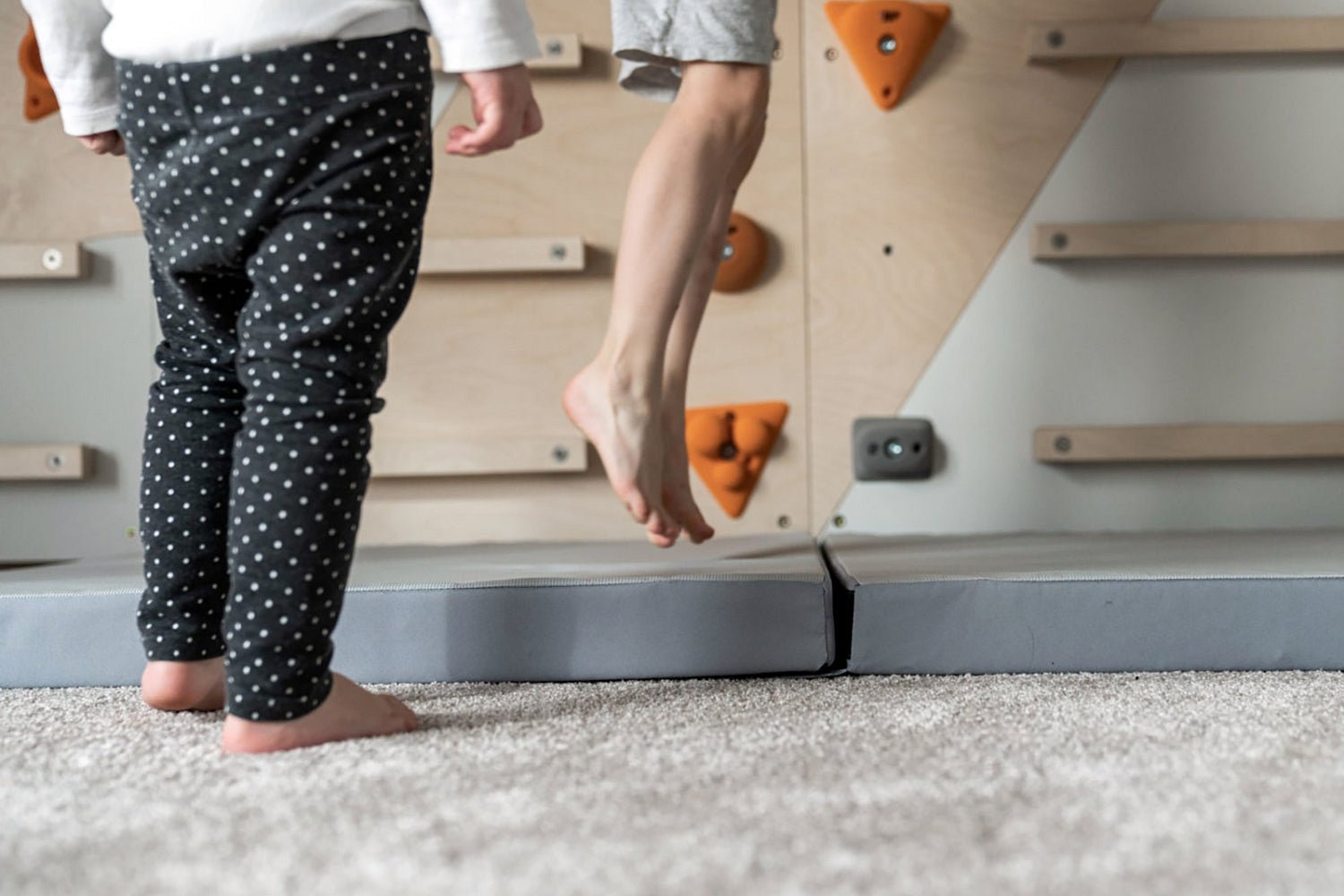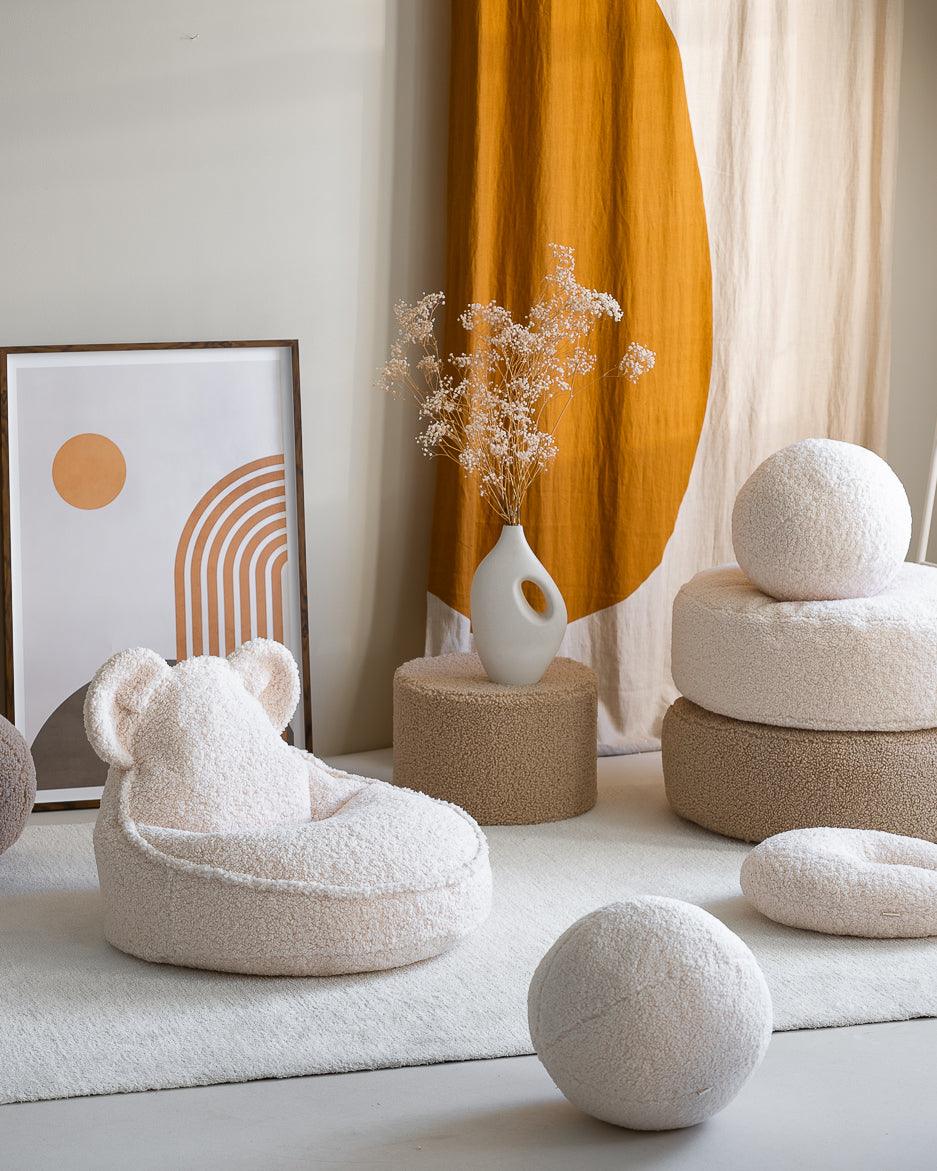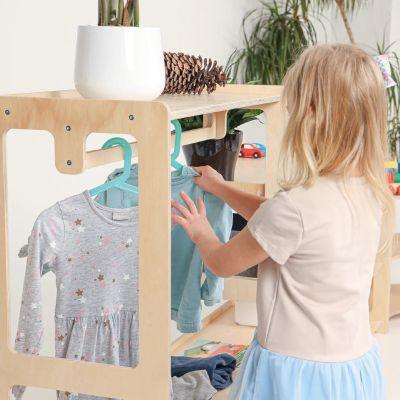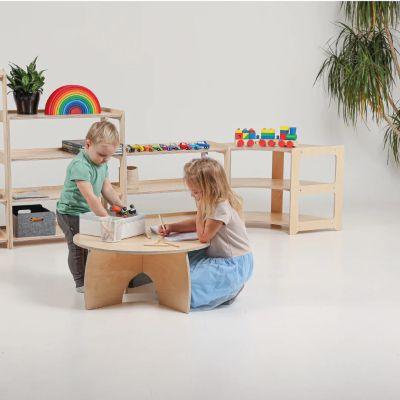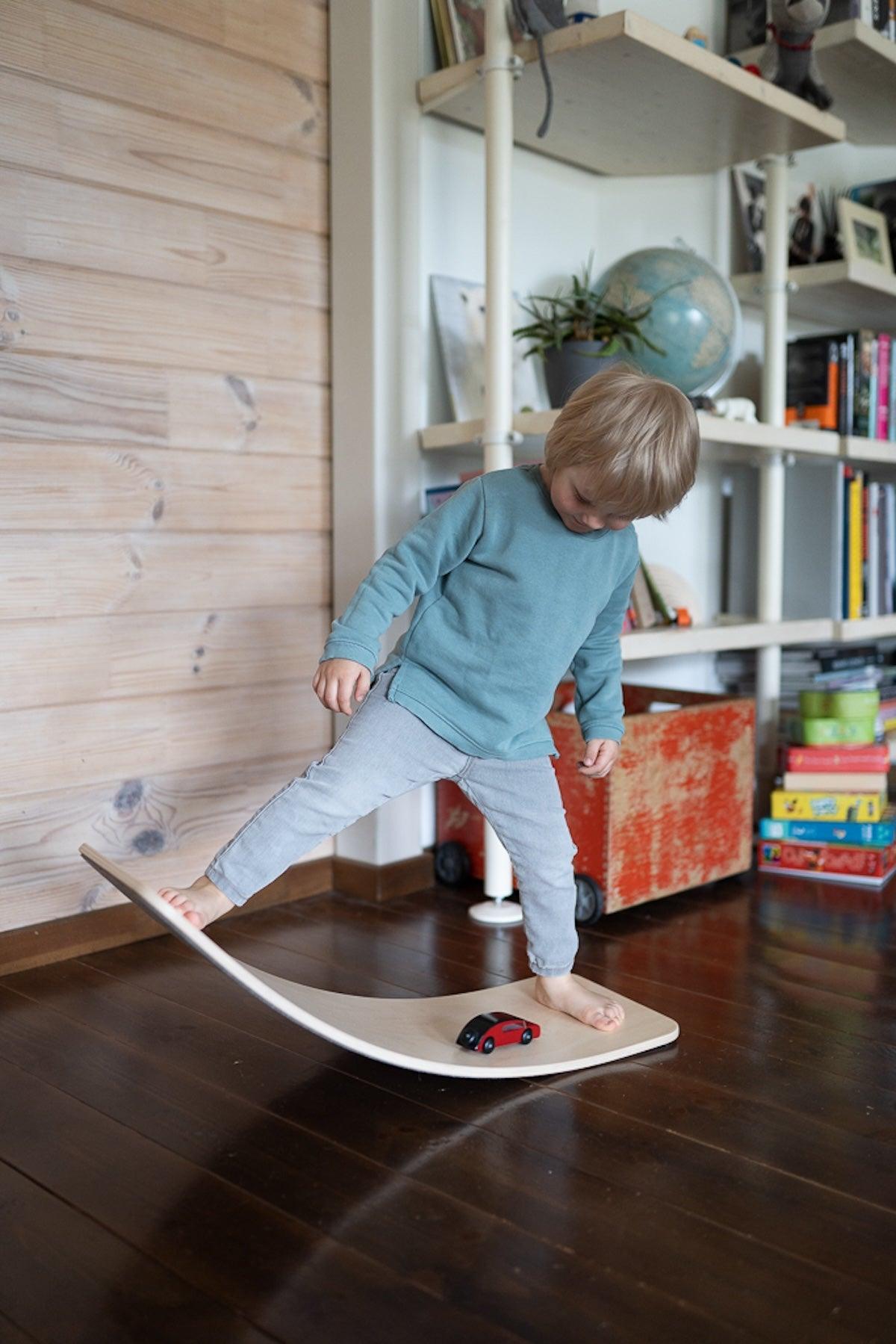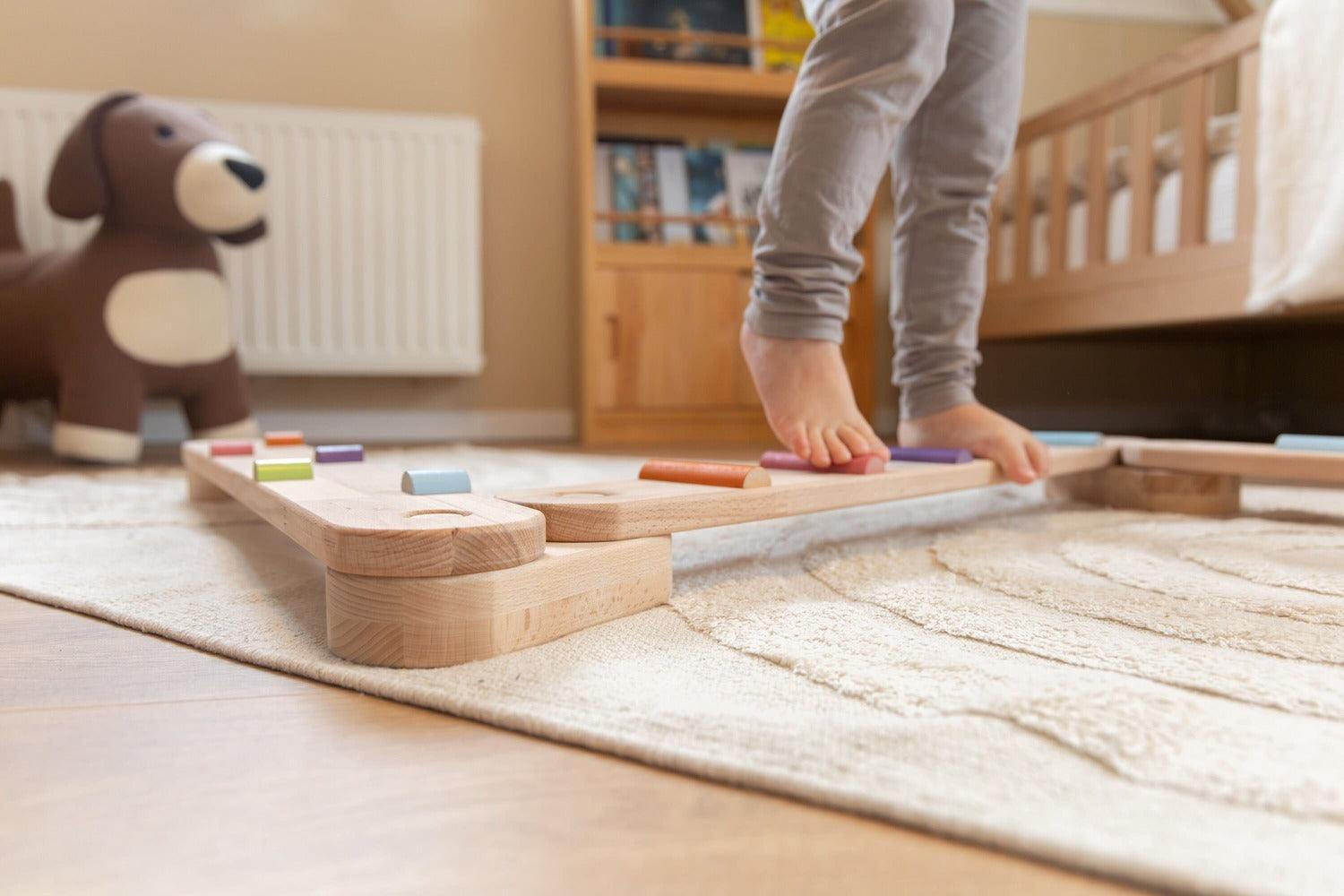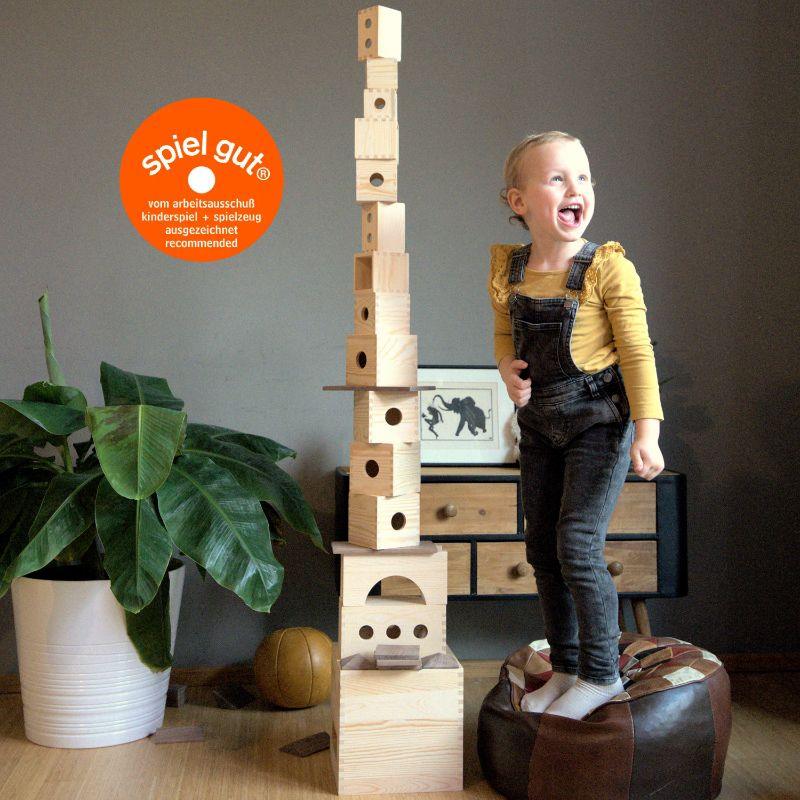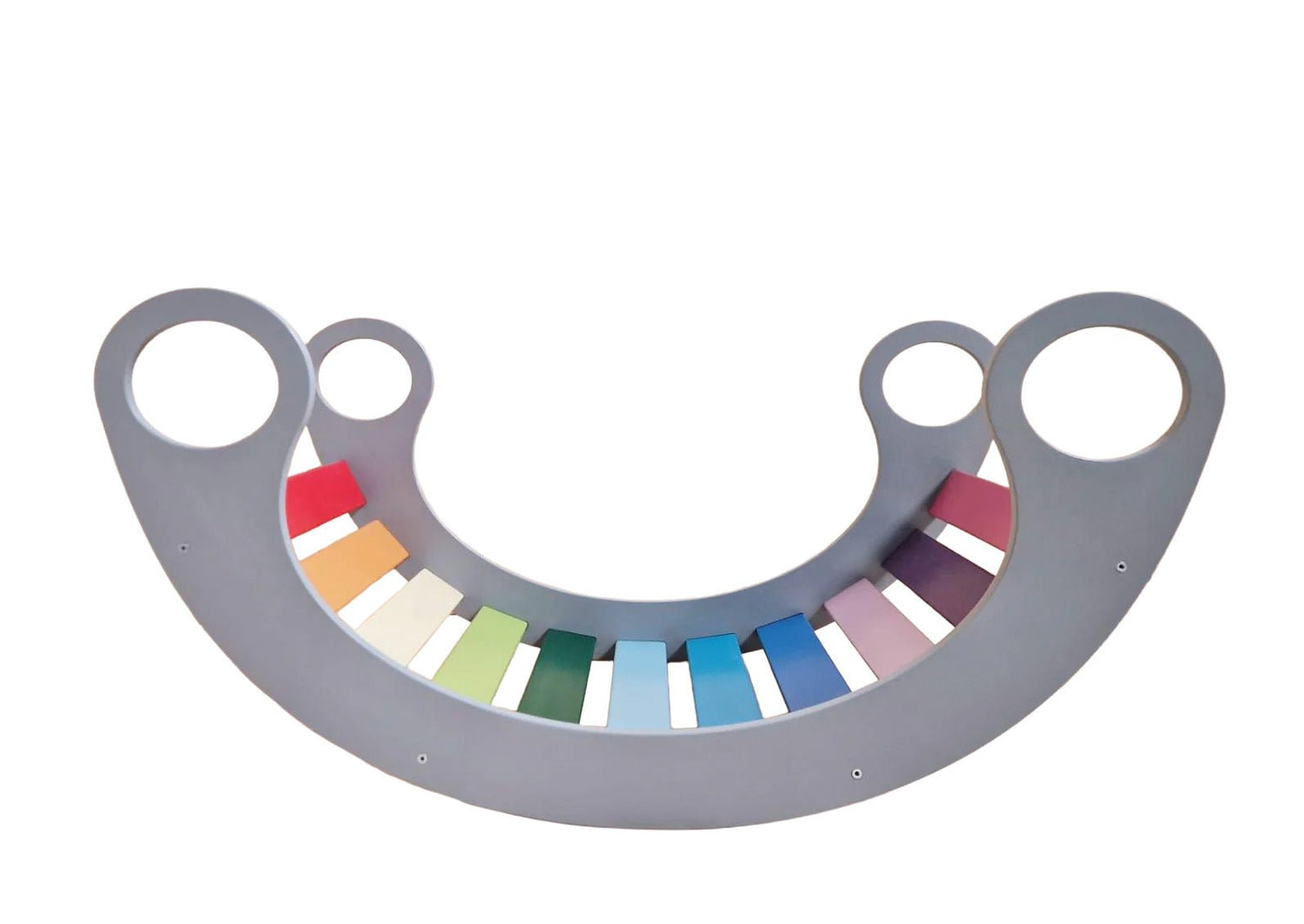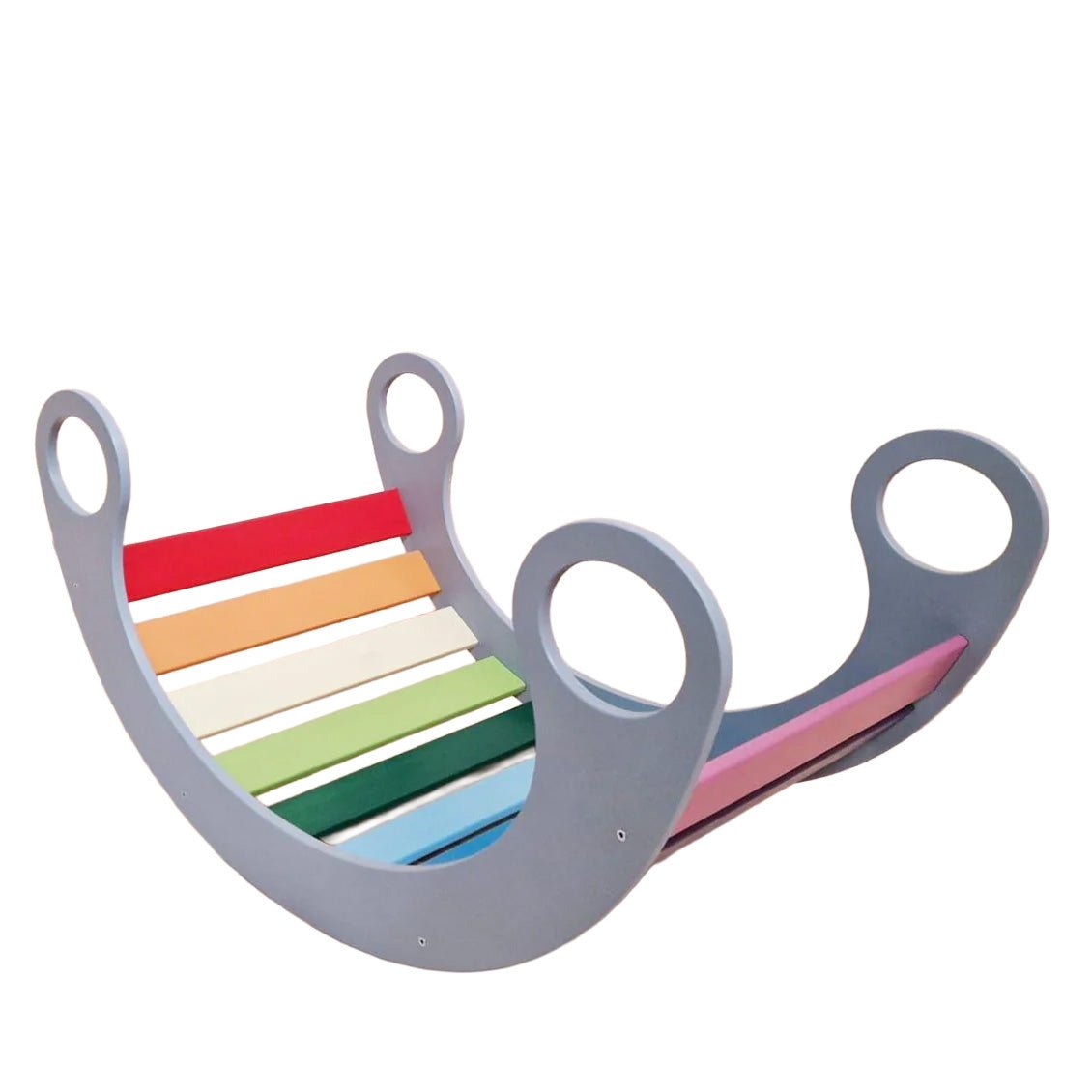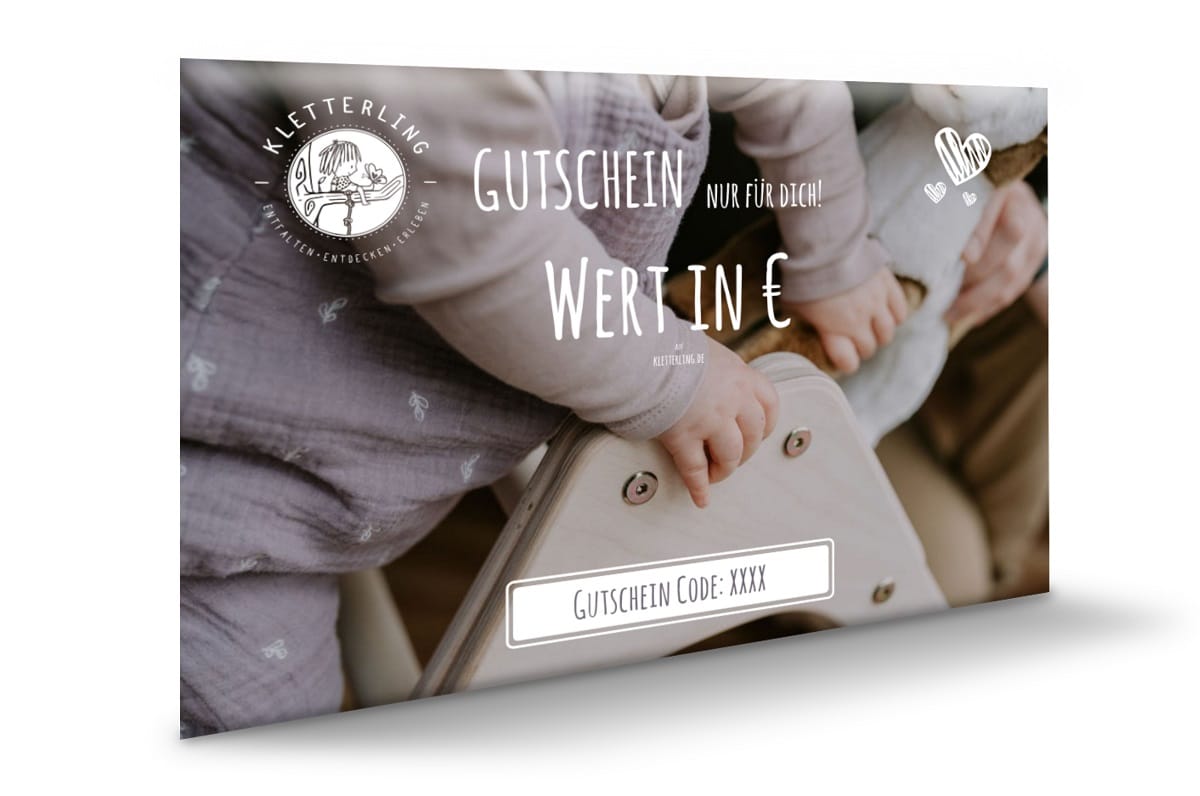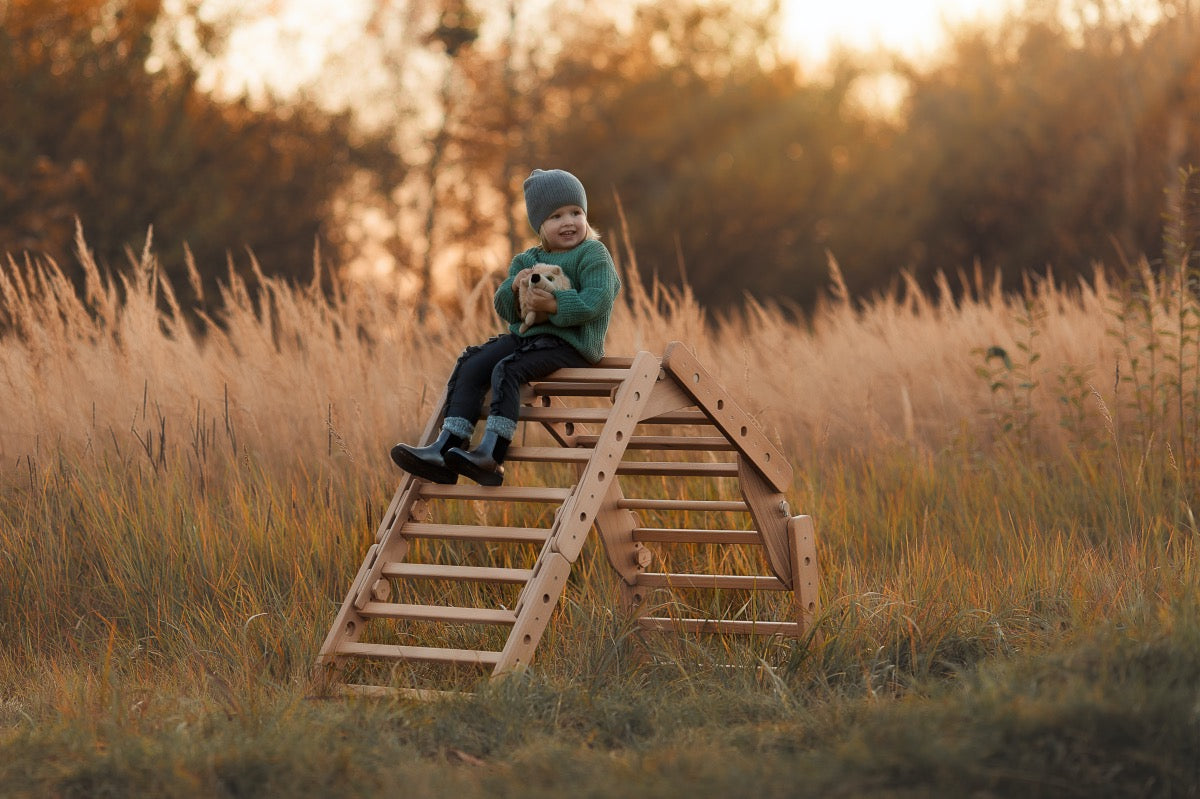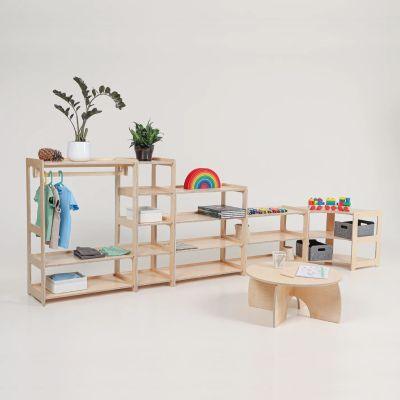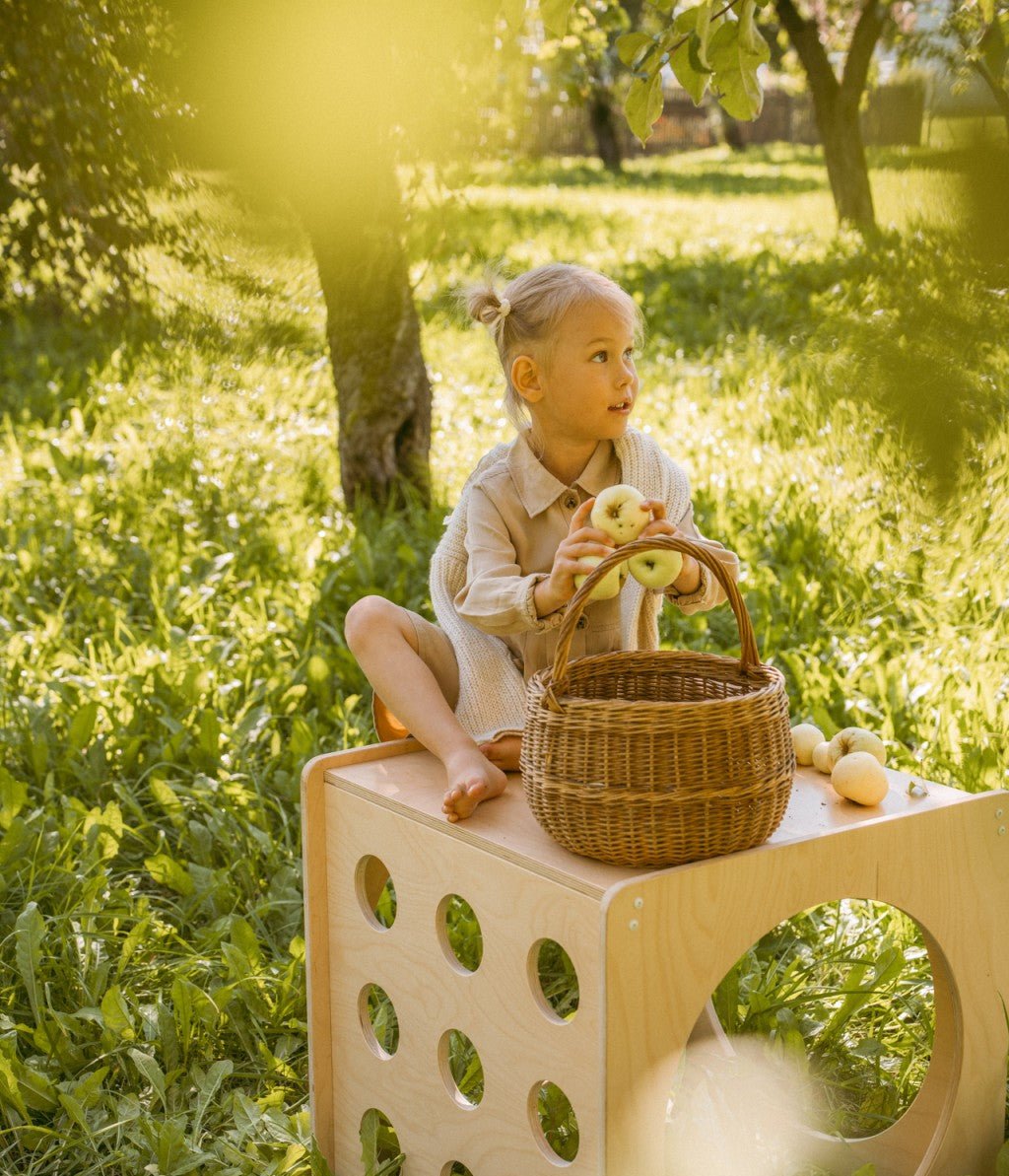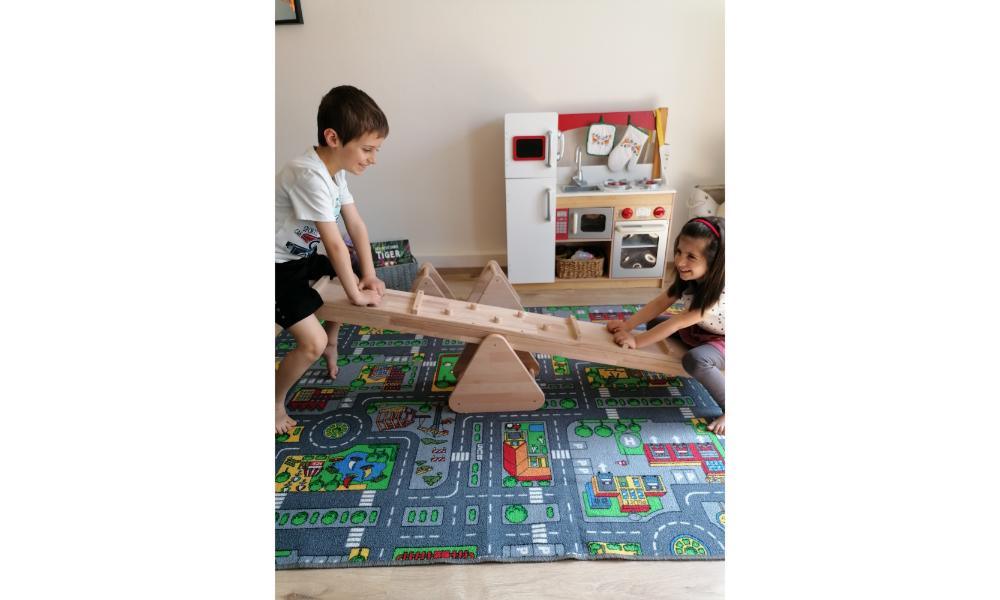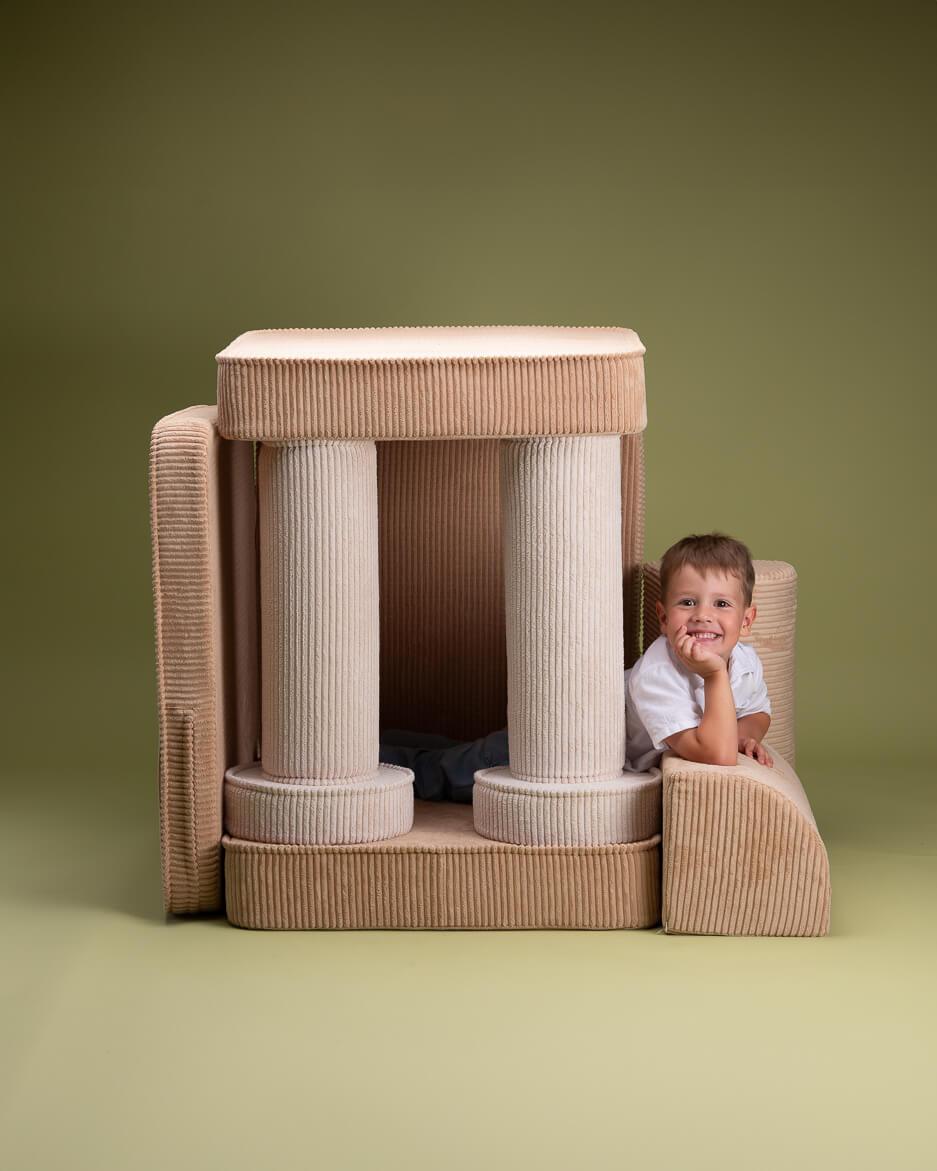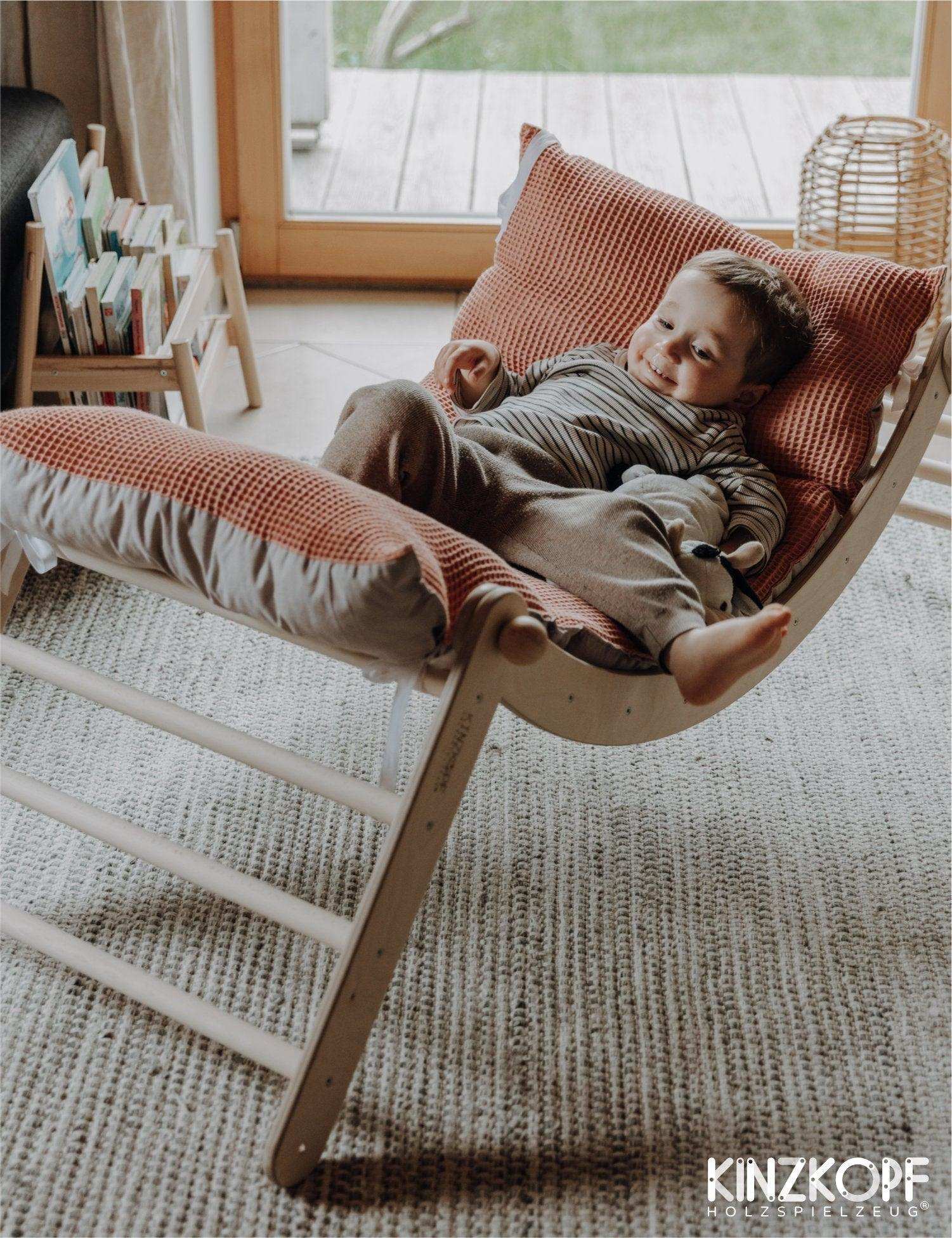Sort by:
11 products
11 products
Discover the versatile KateHaa Montessori rocker
The KateHaa Montessori Seesaw is more than just a children's toy; it's an educational investment in your child's development. Inspired by the core principles of Montessori education, this seesaw combines captivating design and multifunctional use to provide your child with unique and enriching play experiences. Suitable for a wide range of activities, our wooden toy not only promotes balance and coordination, but also supports your child's physical development and independent play.
Unique benefits for your child:
- Promote physical skills: Improved balance and increased coordination of movements through active play.
- Strengthening creativity: Leaves room for endless play possibilities – from a seesaw to a climbing frame to a slide.
- Adaptability: Selectable color options (rainbow, pastel, natural) and the addition of a multifunctional ramp for diverse play fun.
- Safe comfort: A matching cushion ensures a comfortable and safe play environment.
- Sustainable material: The use of responsibly sourced birch and Baltic birch plywood, treated with water-based varnishes and paints, emphasizes our commitment to the environment.
Product features
| feature | information |
|---|---|
| Mass | Length: 89 cm, Width: 47 cm, Height: 49 cm |
| material | Birch wood, Baltic birch plywood |
| Maximum load | 50 kg |
| finish | Treated with water-based varnishes and paints |
| Certification | Tested by the SGS Institute in Germany, complies with the Toy Safety Directive 2009/48/EC |
Kletta's tip
Choosing the KateHaa Montessori Rocker not only promotes your child's physical and creative development, but also symbolizes a commitment to sustainability and environmentally friendly play. At Kletterling, we support you in choosing high-quality, safe, and educationally meaningful toys. Our careful selection of products reflects our commitment to transparency, excellent customer service, and sustainable production conditions. Choose consciously – for the well-being of your child, the environment, and a sustainable future.
Main features of the KateHaa XXL Foldable Climbing Arch
The KateHaa XXL Foldable Climbing Arch is a creative and adaptable toy, uniquely designed to provide children with exciting and educational playtime. Inspired by Montessori principles, this climbing arch encourages free and creative play while improving motor skills such as coordination, strength, and balance. Its versatility knows no bounds: From a classic climbing frame to an imaginative pirate ship, it offers endless possibilities for adventures in your child's imagination.
Advantages of using:
- Improve motor skills: Promotes coordination, strength and balance in your child through free climbing and playing.
- Space-saving: Easily folds up to save valuable space when the toy is not in use.
- Adaptable: Transforms into a seesaw, climbing frame, rocking chair and more for unlimited play options.
- Sustainability: Made from responsibly sourced birch wood and Baltic birch plywood, with water-based varnishes and paints for an environmentally friendly play experience.
- Child-safe: All products are tested and certified according to the highest safety standards.
Product features
| feature | information |
|---|---|
| Mass | Length: 109 cm, Width: 63 cm, Height: 60 cm |
| material | Birch wood, Baltic birch plywood |
| Maximum load | 50 kg |
| finish | Treated with water-based varnishes and paints |
| Certification | SGS Institute in Germany, Toy Safety Directive 2009/48/EC |
Choose from a range of gorgeous colors and complement the fun with a multifunctional ramp that also serves as a slide to make adventures even more exciting. The included cushion makes playtime not only safer but also more comfortable.
Kletta's tip
Choosing a sustainable and educational toy like the KateHaa XXL Foldable Climbing Arch is a conscious and responsible decision that not only supports your child's development but also contributes to environmental protection. At Kletterling, we place the greatest emphasis on transparency, excellent customer service, and always strive for sustainable and fair production conditions. In partnership with manufacturers who guarantee the highest standards of quality, safety, and design, we offer you a selection that inspires your child to learn and grow through play, while simultaneously protecting the environment. By purchasing this product, you not only make your child happy but also support a sustainable and responsible lifestyle.
Main features of the KateHaa XXL climbing arch
The KateHaa XXL Climbing Arch is a creative and adaptable toy that is uniquely designed to provide children with exciting and educational playtime. Inspired by Montessori education, this climbing arch allows free and creative play while improving motor skills such as coordination, strength and balance. Its versatility knows no bounds: From a classic climbing frame to an imaginative pirate ship, it offers endless possibilities for adventures in your child's imagination.
Advantages of use:
- Improves motor skills: Promotes coordination, strength and balance in your child through free climbing and play.
- Adaptable: Transforms into a seesaw, climbing frame, rocking chair and more for unlimited play options.
- Sustainability: Made from responsibly sourced birch wood and Baltic birch plywood, with water-based varnishes and colours for an eco-friendly play experience.
- Child-safe: All products are tested and certified to the highest safety standards.
Product features
| Feature | |
|---|---|
| Information | |
| Dimensions | |
| Length: 109 cm, width: 60 cm, height: 60 cm | |
| Material | |
| Birch wood, Baltic birch plywood | |
| Maximum load | |
| 50 kg | |
| Finish | |
| Treated with water-based paints and varnishes | |
| Certification | SGS Institute in Germany, Toy Safety Directive 2009/48/EC |
Choose from a range of gorgeous colours and add to the fun with a multifunctional ramp that doubles as a slide to make the adventures even more exciting. The included cushion makes playtime not only safer, but also more comfortable.
Klettas tip
Choosing a sustainable and educational toy like the KateHaa XXL climbing arch is a conscious and responsible choice that not only supports your child's development, but also contributes to environmental protection. At Kletterling, we attach great importance to transparency, excellent customer service and always strive for sustainable and fair production conditions. In partnership with manufacturers who ensure the highest standards in quality, safety and design, we offer you a selection that inspires your child to learn and grow through play while protecting the environment. By purchasing this product, you are not only making your child happy, but also supporting a sustainable and responsible lifestyle and taking the worry out of buying your child the right toy, which in the end will also take the pressure off you.
Montessori Kletterbogen ROOT – Schaukel, Balance & Fantasie in einem, ab 10 Monate
Dieser handgefertigte Montessori-Kletterbogen ist ein echtes Multitalent im Kinderzimmer: Er kann als Schaukel, Balancierbrett, Kletterbogen, Tunnel oder Rückzugsort verwendet werden. Dabei fördert er auf spielerische Weise das Gleichgewicht, die Körperkontrolle, Kreativität und die sensorische Entwicklung deines Kindes.
Mit seinen farbenfrohen Sprossen zieht er alle Blicke auf sich – und ist dennoch stabil und leicht genug, damit Kinder ihn selbstständig nutzen können.
Eigenschaften:
-
Individuell bemalbar: Hauptfarbe (Seiten) & Sekundärfarbe (Sprossen) frei wählbar
-
Belastbar bis 40 kg
-
Fördert Motorik, Gleichgewicht & Fantasie
-
Vielseitig nutzbar: Schaukel, Brücke, Höhle, Balancegerät
-
Abgerundete Kanten & glatte Oberfläche – 100 % kindersicher
-
Lackiert mit 3 Schichten wasserbasiertem, speichelfestem Lack & Farbe
-
Handgefertigt mit Liebe zum Detail
-
Hinweis zur Farbwahl:
Du kannst deinen Kletterbogen in jeder gewünschten Farbkombination bestellen. Die Seiten und Sprossen lassen sich farblich individuell abstimmen – für ein ganz persönliches Lieblingsstück! - Hinweis zur Bestellung: Bitte hinterlasse bei der Bestellung deine Telefonnummer, für die Spedition. Der Bogen wird aufgebaut geliefert.
Technische Details:
| Merkmal | Beschreibung |
|---|---|
| Produktart | Montessori-Kletterbogen |
| Material | Birkenholz, lackiert |
| Maße (L × B × H) | 86 × 46 × 45 cm |
| Gewicht | ca. 4,5 kg |
| Belastbarkeit | bis 40 kg |
| Farbgestaltung | Frei wählbar – Seiten & Sprossen individuell |
| Oberfläche | 3-fach lackiert, wasserbasierte Farben |
| Nutzung | Schaukel, Tunnel, Balancegerät, Spielbrücke |
| Empfohlene Nutzung | Für innen und außen |
| Altersempfehlung | Ab 1 Jahr |
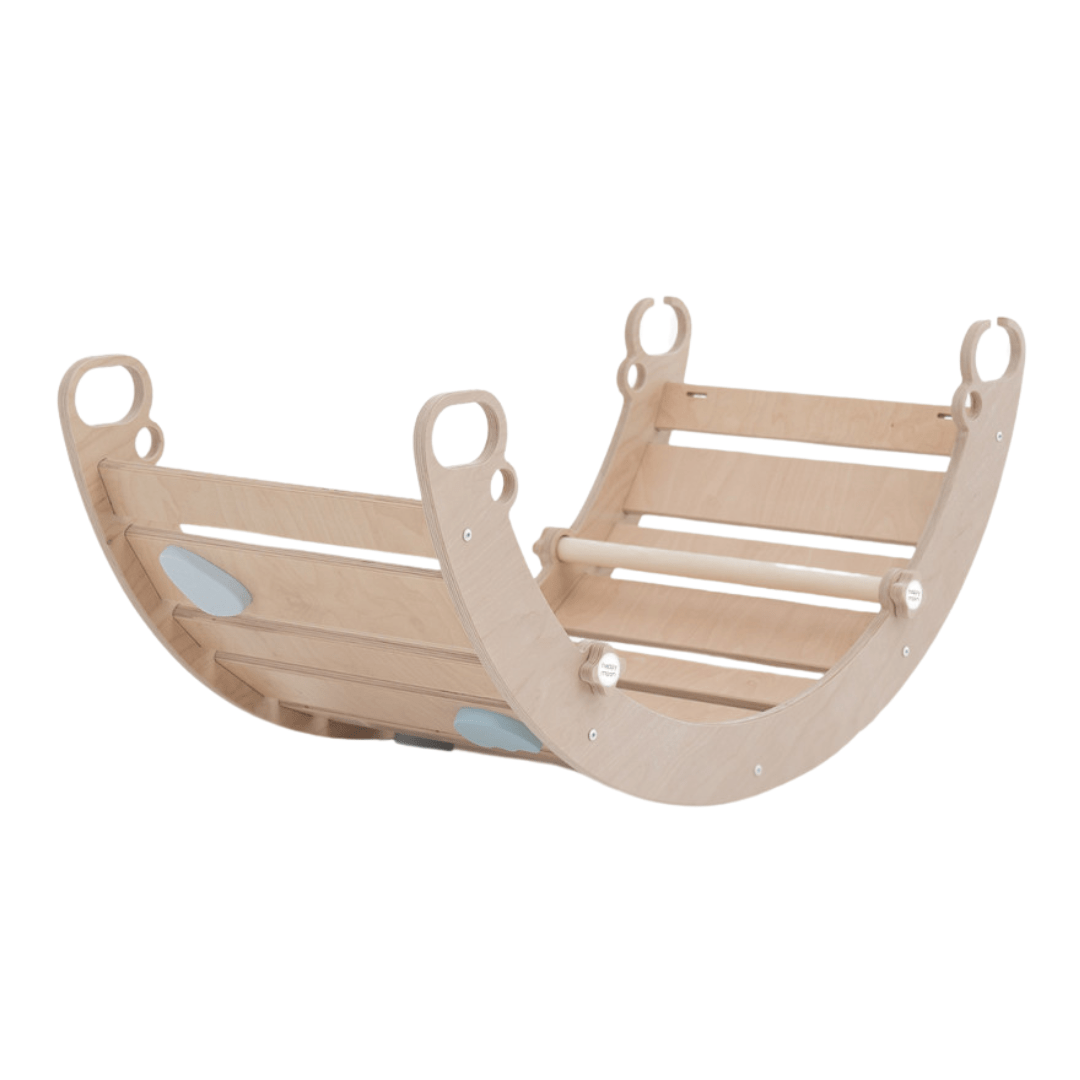
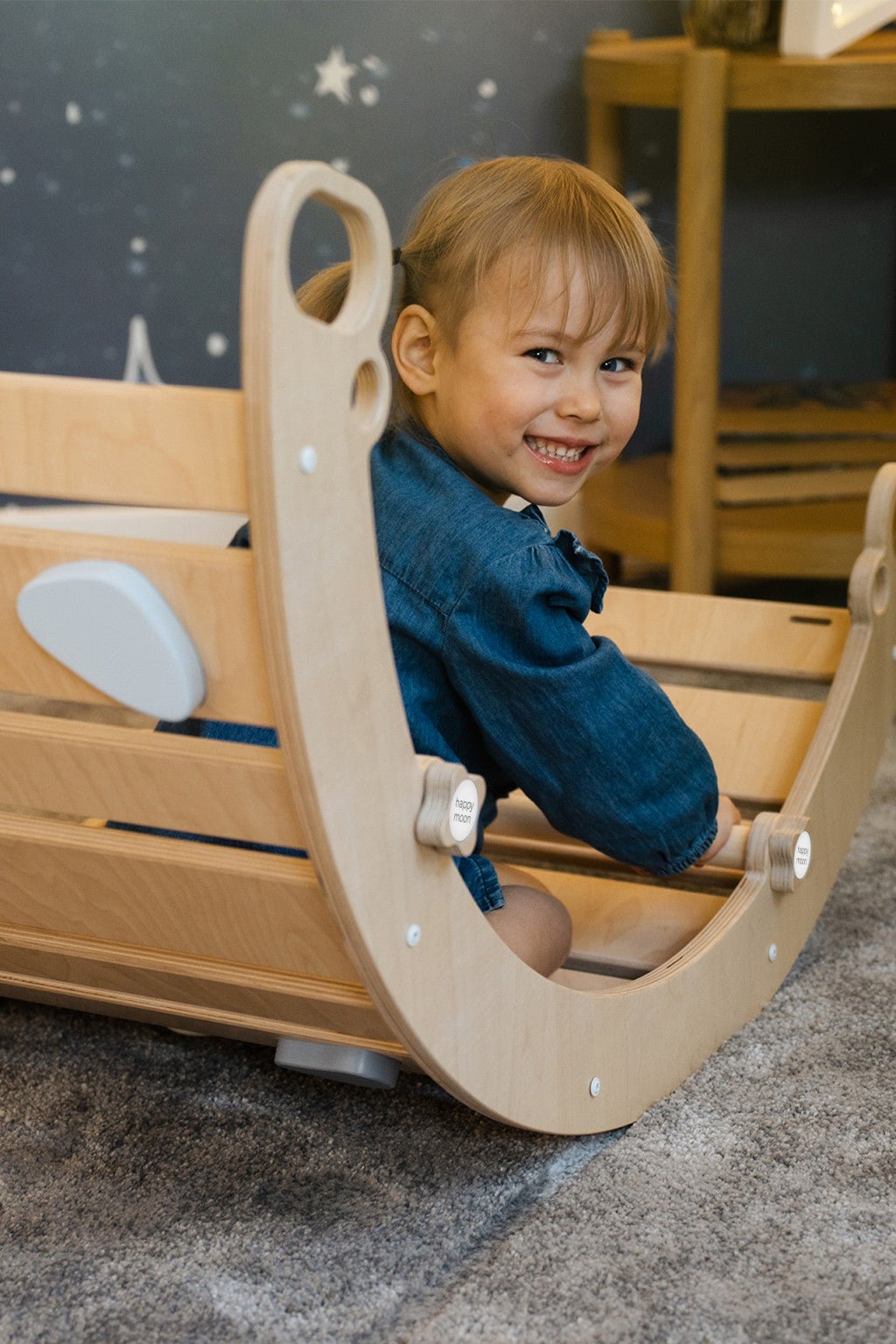
Kletterbogen MOON 3 in 1 | BLAU | 42 cm | Sprossenwand geeignet
€165,60
Unit price perKletterbogen MOON 3 in 1 | BLAU | 42 cm | Sprossenwand geeignet
€165,60
Unit price perKletterbogen MOON 3 in 1 mit blauen Klettersteinen – Wippen, Klettern, Rutschen
Dieses einzigartige 3-in-1-Spielzeug ist Wippe, Kletterbogen und Rampe in einem! Der MOON Kletterbogen fördert motorische Fähigkeiten, Balance, Kreativität und macht jede Menge Spaß – perfekt für kleine Entdecker ab 1 Jahr.
Technische Daten:
• Größe Kletterbogen: HxBxT 42 x 98 x 47 cm
• Produktgewicht: 9 kg
• Paketmaße: 102 × 50 × 9 cm
• Farbe: Blau
• Altersempfehlung: ab 1 Jahr
• Material: Hochwertiges baltisches Birkensperrholz, lackiert mit kindersicherer, wasserbasierter Farbe
Lieferumfang:
• 1 × Moon Kletterbogen
• 2 × Dübel
• 4 × kleine Moon-Schrauben
• Montageanleitung
Multifunktional einsetzbar:
• Als Wippe: Einfach umdrehen – schon entsteht eine stabile Schaukel, auf der Kleinkinder sicher schwingen können.
• Als Kletterbogen: Durch die aufgesetzten Trittsteine wird spielerisch Balance und Kognition gefördert.
• Als Kletterrampe: Perfekt kombinierbar mit dem MOON Kletterdreieck, um ein vielseitiges Indoor-Spielplatzsystem zu schaffen.
Fördert wichtige Fähigkeiten:
• Verbesserung von Gleichgewicht, Koordination und Beweglichkeit
• Stärkung der Muskulatur und Erwerb motorischer Fähigkeiten
• Förderung von Selbstvertrauen und kognitiver Entwicklung
• Sorgt für Ausgeglichenheit, guten Schlaf und beste Laune
Montagehinweis:
Das Produkt wird unmontiert geliefert, um Transportschäden und hohe Versandkosten zu vermeiden. Die Montage sollte ausschließlich durch Erwachsene erfolgen.
Pflege & Verwendung:
• Für den Innenbereich geeignet, sollte nicht im Freien aufbewahrt werden
• Holz vor Feuchtigkeit und direkter Sonneneinstrahlung schützen
• Reinigung mit trockenem oder leicht feuchtem Tuch (keine scharfen Reinigungsmittel verwenden)
Sicherheit: Damit dein Kind rundum geschützt ist, empfehlen wir die Nutzung immer unter Aufsicht eines Erwachsenen. Unsere Produkte sind sorgfältig getestet – dennoch bitten wir um Verständnis, dass wir keine Verantwortung für etwaige Unfälle übernehmen können.
Hochwertige Handwerkskunst – gefertigt in der EU
Der MOON Rocker wird in liebevoller Handarbeit in Lettland (EU) hergestellt und entspricht höchsten Qualitäts- und Sicherheitsstandards (CE-zertifiziert, getestet nach EU-Richtlinie 2009/48/EG). Inspiriert von den Prinzipien von Montessori, Pikler und Waldorf – für echtes, freies Spielen und langfristige Freude.
Hier gehts zu YouTube:
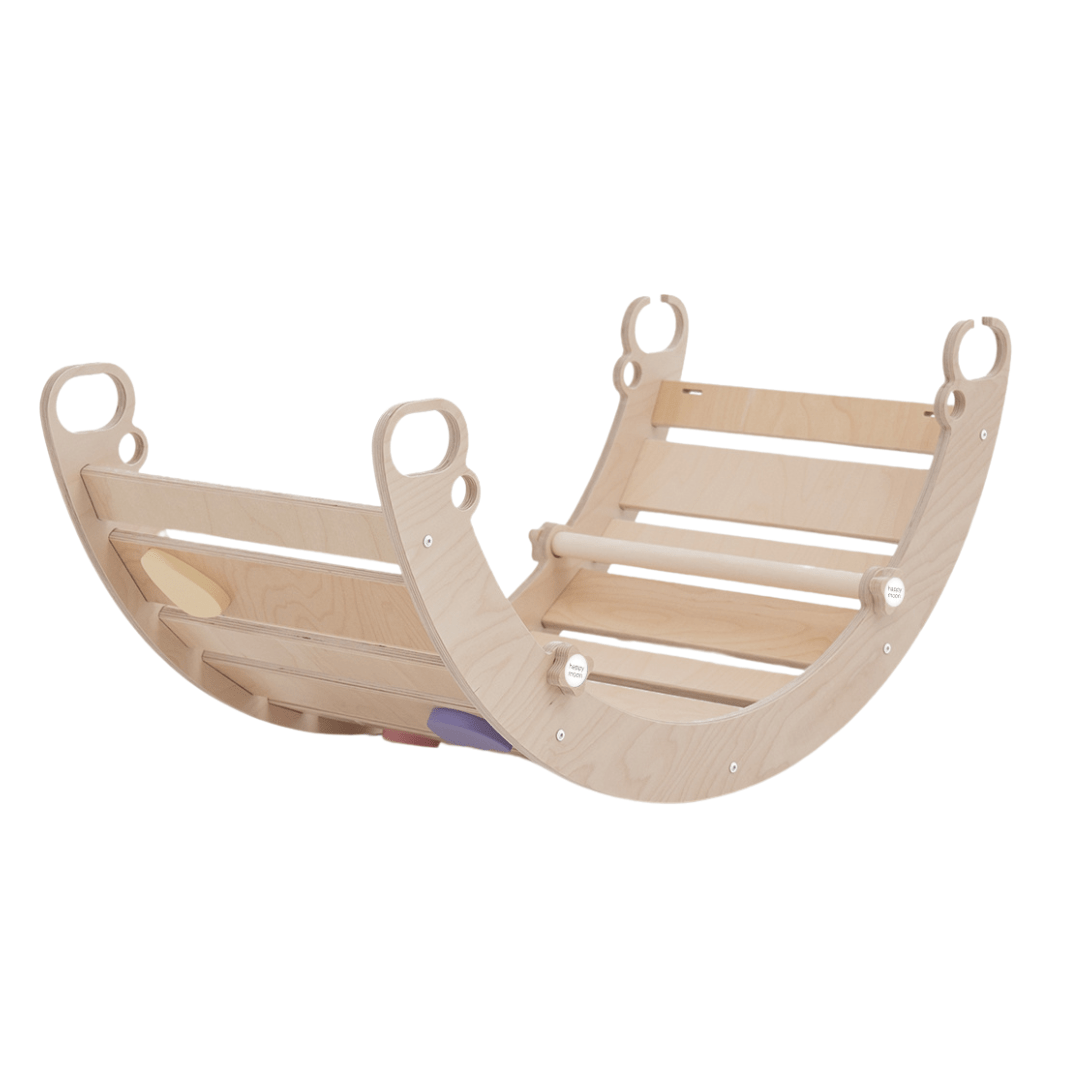
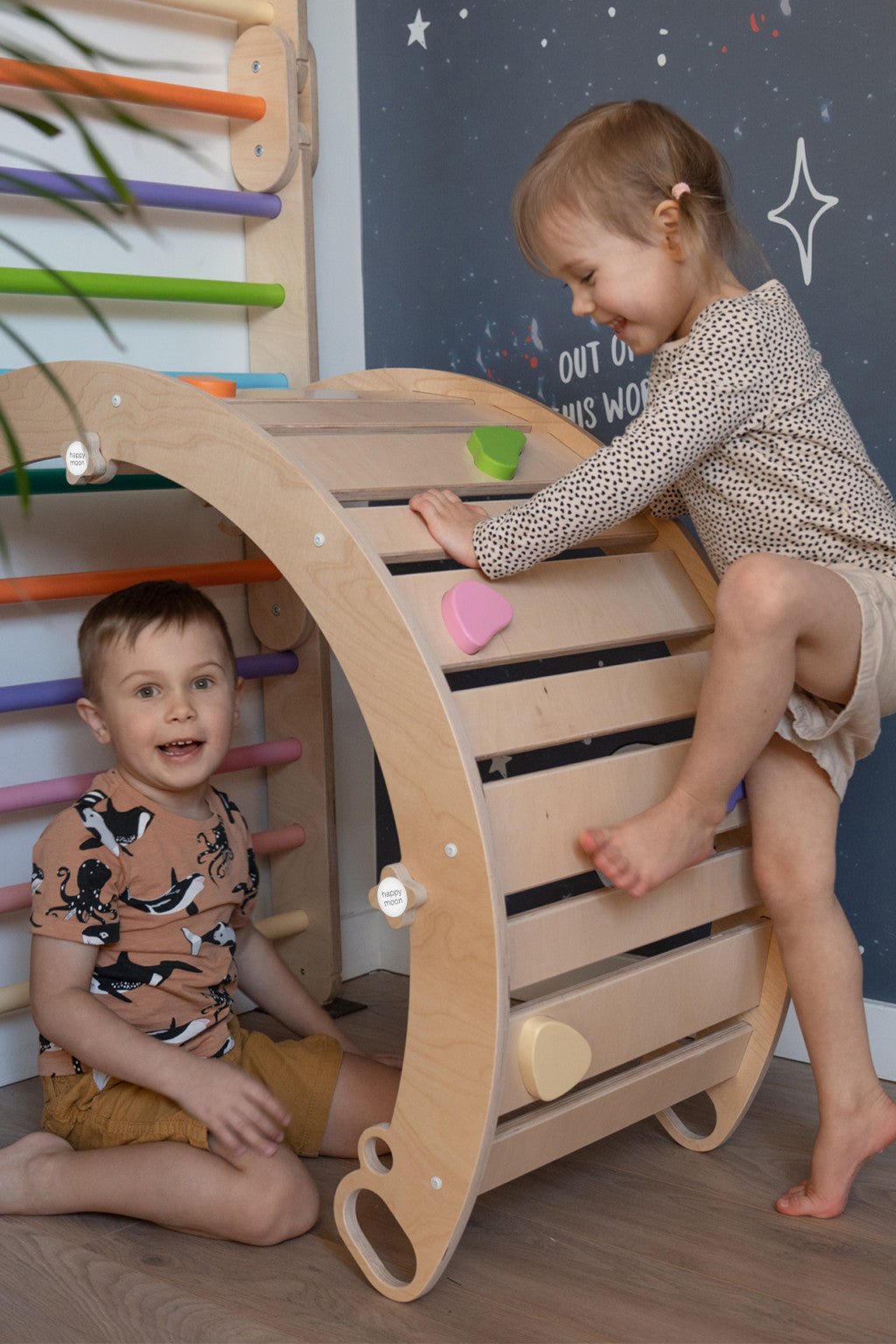
Kletterbogen MOON 3 in 1 | BUNT | 42 cm | Sprossenwand geeignet
€165,60
Unit price perKletterbogen MOON 3 in 1 | BUNT | 42 cm | Sprossenwand geeignet
€165,60
Unit price perMOON 3-in-1 Kletterbogen mit bunten Klettersteinen – Schaukel, Rampe und Balance-Element in einem.
Vielseitiges Bewegungsspielzeug – für drinnen
Dieses multifunktionale Spielgerät ist Kletterbogen, Rutsche und Schaukel zugleich! Kinder können darauf balancieren, schaukeln, klettern oder kreative Spiele erfinden – eine echte Bereicherung für jedes Kinderzimmer.
Technische Daten:
• Produktgröße: HxBxT 42 x 98 x 47 cm
• Produktgewicht: 9 kg
• Paketmaße: 102 × 50 × 9 cm
• Farbe: Bunt
• Altersempfehlung: ab 1 Jahr
Lieferumfang:
• 1 x MOON Kletterbogen (Bunt)
• 2 x Dübel und 4 x MOON Schrauben zur Montage
Verwendungsmöglichkeiten:
• Als Wippe: Einfach den Bogen umdrehen – schon wird er zur stabilen Kinderschaukel.
• Als Kletterbogen: Die integrierten Klettersteine fördern spielerisch die Geschicklichkeit und Koordination.
• Als Rampe: In Kombination mit einem MOON Kletterdreieck oder Sprossenwand wird daraus eine spannende Kletterrampe.
Fördert wichtige Fähigkeiten:
• Verbesserung von Gleichgewicht, Koordination und Beweglichkeit
• Stärkung der Muskulatur und Erwerb motorischer Fähigkeiten
• Förderung von Selbstvertrauen und kognitiver Entwicklung
• Sorgt für Ausgeglichenheit, guten Schlaf und beste Laune
Montagehinweis: Der Kletterbogen wird zur Selbstmontage geliefert, um Transportschäden zu vermeiden und Versandkosten niedrig zu halten. Die Montage sollte ausschließlich durch Erwachsene erfolgen und Kinder dürfen gerne helfen und den Aufbau zu einem gemeinsamen Erlebnis machen.
Material & Pflege:
• Hochwertiges baltisches Birkensperrholz
• Lackierung mit kindersicherer, wasserbasierter Farbe
• Für den Innenbereich empfohlen, sollte keiner Witterung ausgesetzt werden.
• Reinigung mit einem trockenen oder leicht feuchten Tuch (keine aggressiven Reiniger verwenden)
Sicherheit: Das durchdachte Design schützt kleine Finger zuverlässig vor dem Einklemmen. Die Belastbarkeit liegt bei maximal 50 kg.
Hinweis: Für sicheres Spielen wird eine ständige Begleitung durch Erwachsene empfohlen. Unsere Produkte sind sorgfältig geprüft, dennoch können wir bei Unfällen keine Haftung übernehmen.
Handgefertigte Qualität:
Der MOON Kletterbogen wird in Lettland (EU) von erfahrenen Handwerkern mit größter Sorgfalt hergestellt. Inspiriert von den Prinzipien der Montessori-, Pikler- und Waldorfpädagogik, steht jedes Stück für höchste Qualität, Sicherheit und Langlebigkeit.
Hier gehts zu YouTube:
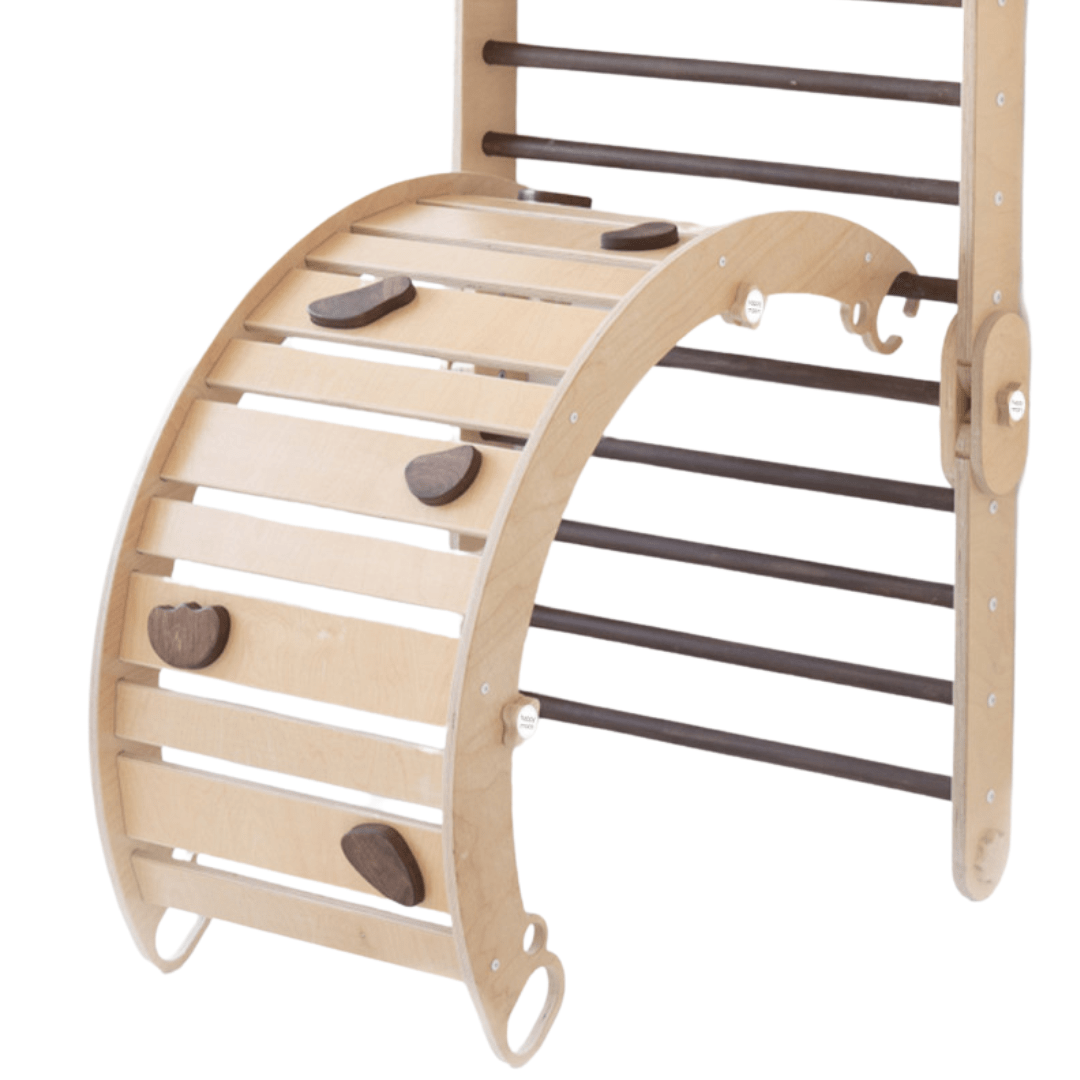
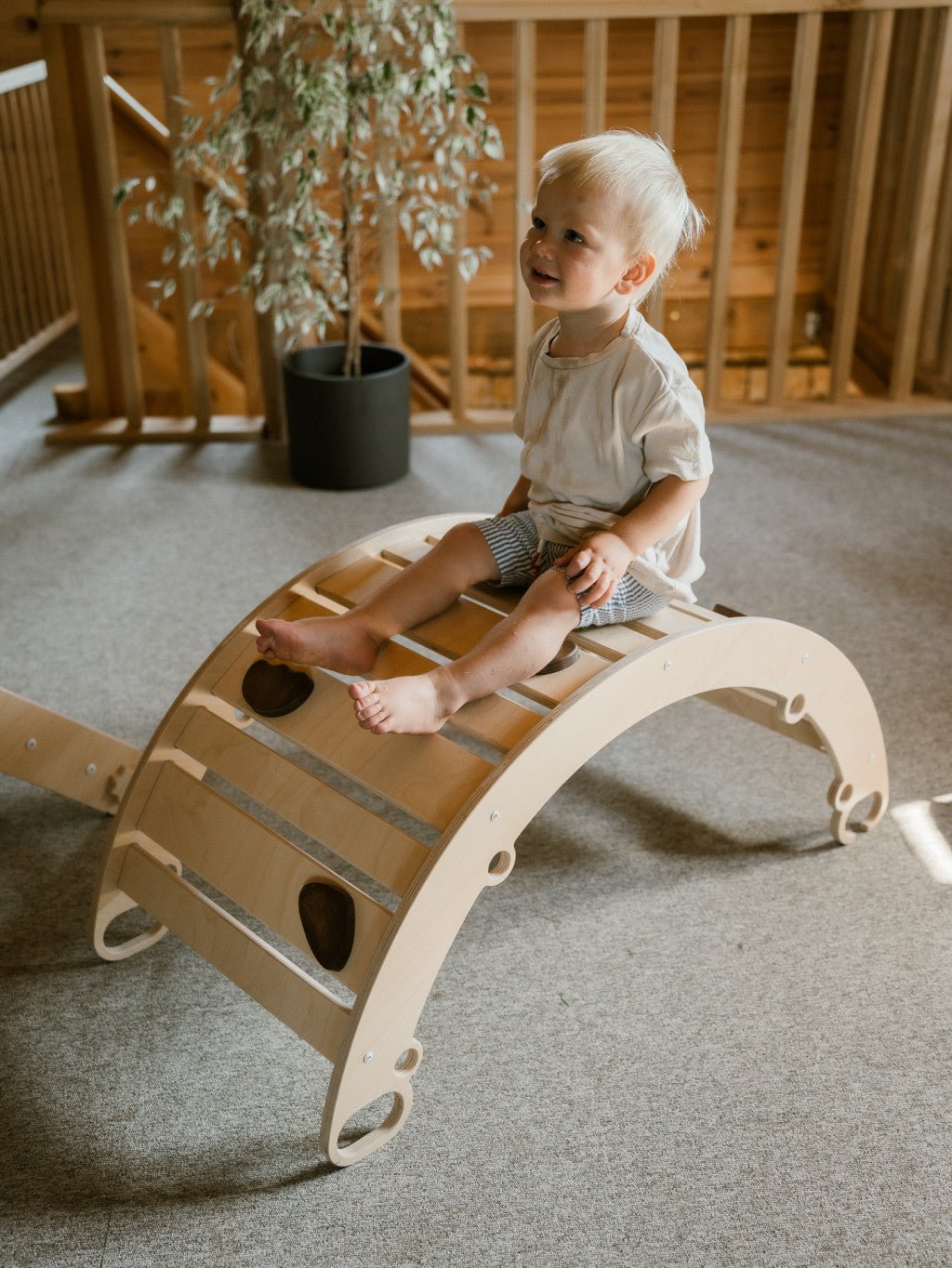
Kletterbogen MOON 3 in 1 | DARKWOOD | 42 cm | Sprossenwand geeignet
€165,60
Unit price perKletterbogen MOON 3 in 1 | DARKWOOD | 42 cm | Sprossenwand geeignet
€165,60
Unit price perKletterbogen MOON 3-in-1 mit Klettersteinen in darkwood – Wippen, Klettern, Rutschen - einhängbar in Kletterdreieck und Sprossenwand
Ein Spielgerät – unzählige Möglichkeiten: Der MOON Kletterbogen vereint Wippe, Kletterbogen und Kletterrampe in einem liebevoll designten 3-in-1-System. Perfekt für kleine Abenteurer ab 1 Jahr, die spielerisch ihre Balance, Motorik und Kreativität entwickeln wollen.
Technische Daten:
• Größe: HxBxT 42 × 98 × 47 cm
• Produktgewicht: 9 kg
• Paketmaße: 102 × 50 × 9 cm
• Farbe: Darkwood
• Altersempfehlung: ab 1 Jahr
• Belastbarkeit: bis 50 kg
• Material: Hochwertiges baltisches Birkensperrholz, lackiert mit kindersicherer, wasserbasierter Farbe
Lieferumfang:
• 1 × MOON Kletterbogen mit Klettersteinen in der Farbe Darkwood
• 2 × Holzdübel
• 4 × kleine MOON-Schrauben
• Montageanleitung
Multifunktional & kreativ:
• Als Wippe: Einfach den Bogen umdrehen und sicheres Schaukeln genießen – perfekt abgestimmt auf Kleinkinder.
• Als Kletterbogen: Die aufgebrachten Trittsteine unterstützen Balance, Motorik und kognitive Entwicklung.
• Als Rampe: In Kombination mit dem MOON Kletterdreieck entsteht ein fantasievolles Kletter- und Rutschsystem für drinnen.
Fördert wichtige Fähigkeiten:
• Verbesserung von Gleichgewicht, Koordination und Beweglichkeit
• Stärkung der Muskulatur und Erwerb motorischer Fähigkeiten
• Förderung von Selbstvertrauen und kognitiver Entwicklung
• Sorgt für Ausgeglichenheit, guten Schlaf und beste Laune
Montagehinweis:
Das Produkt wird zum Selbstaufbau geliefert, um Transportschäden und hohe Versandkosten zu vermeiden. Die Montage sollte ausschließlich durch Erwachsene erfolgen – Kinder sind gerngesehene Helfer um den Aufbau zu einem gemeinsamen Erlebnis zu machen.
Pflege & Verwendung:
• Nur für den Innenbereich geeignet (nicht draußen lagern)
• Holz vor Feuchtigkeit und starker Sonneneinstrahlung schützen
• Reinigung mit trockenem oder leicht feuchtem Tuch (keine aggressiven Reinigungsmittel verwenden)
Sicherheit:
Für ein sicheres Spielvergnügen empfehlen wir, dass Kinder jederzeit von einem Erwachsenen begleitet werden. Unsere Produkte sind sorgfältig getestet – dennoch bitten wir um Verständnis, dass wir keine Verantwortung für etwaige Unfälle übernehmen können.
Handgemachte Qualität – gefertigt in der EU:
Der MOON Kletterbogen wird in präziser Handarbeit in Lettland (EU) hergestellt. Er entspricht den höchsten Sicherheitsstandards (CE-zertifiziert, geprüft nach EU-Richtlinie 2009/48/EG) und ist inspiriert von den Prinzipien der Montessori-, Pikler- und Waldorfpädagogik – für echtes, freies Spielen mit langanhaltender Freude.

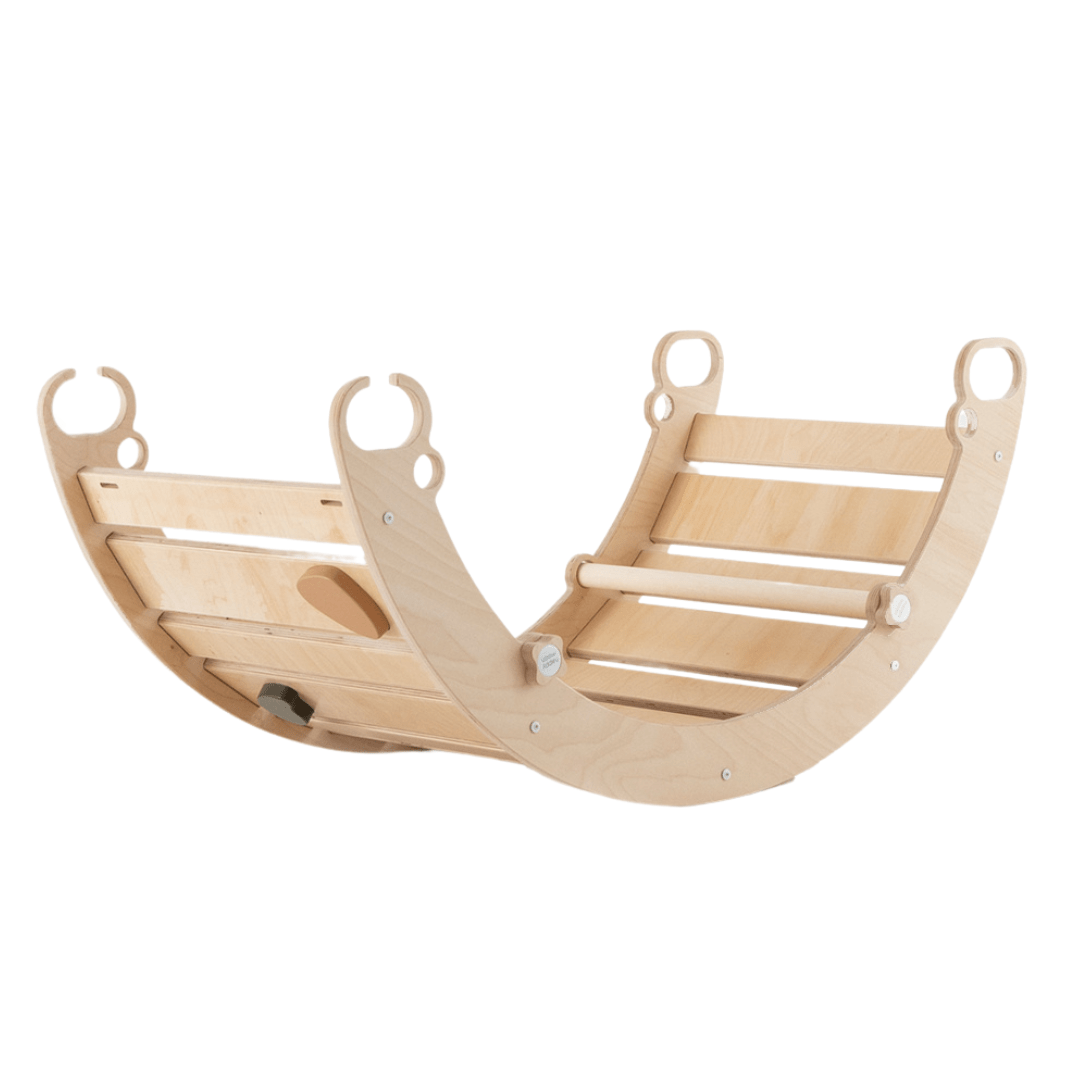
Kletterbogen MOON 3 in 1 | GRÜN | 42 cm | Sprossenwand geeignet
€165,60
Unit price perKletterbogen MOON 3 in 1 | GRÜN | 42 cm | Sprossenwand geeignet
€165,60
Unit price perKletterbogen MOON 3 in 1 - mit grünen Klettergriffen
Der vielseitige MOON 3 in 1 Kletterbogen begeistert als Kletterbogen, Rampe und Wippe – ideal, um Balance, Kraft und Kreativität spielerisch zu fördern. Perfekt für kleine Entdecker ab 1 Jahr, die drinnen aktiv werden möchten.
Technische Daten:
• Größe: HxBxT 42 x 98 x 47 cm
• Gewicht: 9 kg
• Paketmaße: 102 × 50 × 9 cm
• Farbe: Grün
• Altersempfehlung: ab 1 Jahr
• Belastbarkeit: bis 50 kg
• Material: Hochwertiges baltisches Birkensperrholz, mit kindersicherer, wasserbasierter Farbe behandelt
Lieferumfang:
• 1× MOON Kletterbogen mit grünen Klettersteinen
• 2× Holzdübel
• 4× MOON Schrauben
• Anleitung für Aufbau und Nutzung
3-in-1 Multifunktion:
• Als Wippe: Umgedreht wird der Bogen zur stabilen Wippe für entspanntes oder wildes Schaukeln.
• Als Kletterbogen: Der Bogen bietet mit seinen stabilen Klettersteinen spannende Aufstiege und fördert gezielt die motorische Entwicklung.
• Als Rampe: In Kombination mit dem MOON Kletterdreieck entsteht eine vielseitige Rutsche oder Balancierstrecke.
Fördert wichtige Fähigkeiten:
• Verbesserung von Gleichgewicht, Koordination und Beweglichkeit
• Stärkung der Muskulatur und Erwerb motorischer Fähigkeiten
• Förderung von Selbstvertrauen und kognitiver Entwicklung
• Sorgt für Ausgeglichenheit, guten Schlaf und beste Laune
Pflege & Material:
• Für den Innenbereich geeignet (vor Feuchtigkeit und direkter Sonneneinstrahlung schützen)
• Reinigung nur mit trockenem oder leicht feuchtem Tuch – keine aggressiven Reinigungsmittel verwenden
• Hergestellt aus hochwertigem baltischem Birkensperrholz
• Lackiert mit schadstofffreier, wasserbasierter Kinderfarbe
Sicherheit:
Für ein sicheres Spielvergnügen empfehlen wir, dass Kinder jederzeit von einem Erwachsenen begleitet werden. Unsere Produkte sind sorgfältig getestet – dennoch bitten wir um Dein Verständnis, dass wir keine Verantwortung für etwaige Unfälle übernehmen können.
Montage:
Die Montage sollte ausschließlich durch Erwachsene erfolgen und Kinder dürfen gerne helfen und den Aufbau zu einem gemeinsamen Erlebnis machen.
Hochwertige Handarbeit aus Europa:
Alle MOON-Produkte werden liebevoll in Lettland (EU) gefertigt – von erfahrenen Handwerkern, die Wert auf höchste Qualität, Langlebigkeit und ein sicheres, inspirierendes Spielumfeld legen. Jeder Bogen ist ein Unikat, das Kindern über viele Jahre Freude bereitet.
YouTube Video:
https://youtu.be/u0TuAl3Be1w

Kletterbogen RAINBOW | 2-in-1 Bogen & Wippe | mit bunten Seilsprossen
€699,99
Unit price perKletterbogen RAINBOW | 2-in-1 Bogen & Wippe | mit bunten Seilsprossen
€699,99
Unit price perKletterbogen RAINBOW – Wippe, Bogen & Bewegungstraining in einem
Für mutige kleine Entdecker:innen – der vielseitige Kletterbogen mit bunten Seilsprossen
Kletterbogen RAINBOW ist ein echtes Multitalent für Spiel, Sport und Therapie. Ob als Hindernis, Wippe oder fantasievolle Brücke: Dieses Bewegungselement fördert auf spielerische Weise Gleichgewicht, Kraft und Koordination. Die flexiblen Seilsprossen in bunten Farben machen das Klettern zur echten Herausforderung – und wecken mit ihrem besonderen Reiz die natürliche Neugier und den Bewegungsdrang jedes Kindes.
Highlights auf einen Blick
- 3-in-1: Kletterbogen, Wippe & Brücke
- Mit bunten, nachgebenden Seilsprossen – für mehr Körperspannung & Gleichgewicht
- Umgedreht als Brücke nutzbar – ideal für Parcours
- Mit Matte kombinierbar – als sichere Wiege in Therapie & Spiel
- Stabil & belastbar bis 100 kg
- Wangen aus stabilem Multiplex-Holz, Sprossen in der Mitte & an den Enden aus Massivholz
- Made in Germany – langlebige, geprüfte Qualität
- Für Kita, Verein, Therapie oder Zuhause
Produktdetails
| Merkmal | Details |
|---|---|
| Produktgröße | 210 × 35 × 39 cm (L × B × H) |
| Material | Multiplex-Holz, Seilsprossen |
| Gewicht | 20 kg |
| Max. Belastbarkeit | 100 kg |
| Empfohlene Nutzung | Indoor – Kita, Verein, Therapie |
Aufbau
Das Produkt wird fertig montiert geliefert oder ist mit wenigen Handgriffen einsatzbereit. Bitte stelle sicher, dass der Kletterbogen auf einem ebenen, rutschfesten Untergrund genutzt wird. Eine Nutzung mit Turnmatten wird empfohlen.
Sicherheit
Damit dein Kind rundum geschützt ist, empfehlen wir die Nutzung immer unter Aufsicht eines Erwachsenen. Alle Materialien sind geprüft und für Kinder geeignet. Dennoch erfolgt die Nutzung auf eigene Verantwortung.
Pflege & Verwendung
Für den Innenbereich empfohlen. Holz mit trockenem oder leicht feuchtem Tuch reinigen. Keine aggressiven Reinigungsmittel verwenden. Vor Feuchtigkeit schützen.
Handwerkskunst
Made in Germany: Der Kletterbogen RAINBOW wird direkt in Deutschland gefertigt – aus hochwertigen Materialien und mit einem tiefen Verständnis für kindgerechte Bewegung und Therapieeinsätze.
Kletterbogen RAINBOW – spielerische Vielfalt auf kleinem Raum
Kletterbogen RAINBOW ist das perfekte Element für jeden Bewegungsparcours. Ob als Klettergerät, Brücke oder entspannende Wiege – er fördert Körperwahrnehmung, Balance und Spaß an Bewegung. Ideal für Kinder ab 3 Jahren in Kitas, Vereinen oder integrativen Einrichtungen.
Suchst du nach einem Geschenk, das garantiert Freude bereitet und genau den Geschmack des Beschenkten trifft? Mit einem Kletterling Geschenkgutschein liegst du immer richtig! Unser Gutschein ist die ideale Lösung für alle, die Kindern eine Freude machen möchten, aber nicht sicher sind, welches unserer hochwertigen Spielgeräte am besten passt.
Warum ein Kletterling Gutschein das perfekte Geschenk ist
Ein Geschenkgutschein von Kletterling bietet weit mehr als nur einen Warenwert – er schenkt Wahlfreiheit, Vorfreude und die Möglichkeit, genau das Spielgerät auszusuchen, das perfekt zu den individuellen Bedürfnissen und Wünschen des Kindes passt.
Die Vorteile unseres Gutscheins auf einen Blick:
• Flexible Auswahl – Der Beschenkte kann selbst entscheiden, ob er einen Kletterbogen, eine Matschküche, ein Kindersofa oder eines unserer vielen anderen Qualitätsprodukte wählt
• Langfristige Gültigkeit – Unser Gutschein ist 3 Jahre lang einlösbar, sodass genügend Zeit für die perfekte Auswahl bleibt
• Persönliches Geschenk – Du kannst den Gutscheinbetrag frei wählen und so an dein Budget anpassen
• Einfache Einlösung – Problemlose Verwendung in unserem Online-Shop mit nur wenigen Klicks
• Sofort verfügbar – Nach dem Kauf erhältst du den Gutschein direkt per E-Mail zum Ausdrucken oder Weiterleiten
So funktioniert der Kletterling Gutschein
Unser Gutscheinsystem ist bewusst einfach und unkompliziert gestaltet:
1. Wunschbetrag auswählen – Entscheide dich für einen Betrag deiner Wahl
2. Bestellen und bezahlen – Wie bei einem normalen Produkt in unserem Shop
3. Gutschein erhalten – Der Gutscheincode wird dir per E-Mail zugesendet
4. Verschenken – Drucke den Gutschein aus oder leite die E-Mail weiter
5. Einlösen – Der Beschenkte kann den Gutscheincode bei seiner Bestellung im Warenkorb einlösen
Der perfekte Anlass für einen Kletterling Gutschein
Ob Geburtstag, Weihnachten, Ostern oder einfach als Überraschung zwischendurch – ein Kletterling Gutschein passt zu jedem Anlass:
• Zum Geburtstag – Schenke die Freiheit, sich einen langgehegten Wunsch zu erfüllen
• Zu Weihnachten – Der ideale Gutschein für unter den Weihnachtsbaum
• Zur Geburt oder Taufe – Ein wertvolles Geschenk, das für die Zukunft des Kindes investiert wird
• Für Großeltern, Paten und Freunde – Die perfekte Lösung, wenn man nicht täglich mit dem Kind zusammen ist und seine aktuellen Wünsche kennt
Qualität und Werte schenken
Mit einem Kletterling Gutschein verschenkst du nicht nur einen Warenwert, sondern auch unsere Philosophie: hochwertige, entwicklungsfördernde Spielgeräte, die mit Liebe zum Detail gefertigt werden und Kindern helfen, ihre motorischen und kognitiven Fähigkeiten spielerisch zu entfalten.
Unser Sortiment umfasst ausschließlich Produkte, die wir sorgfältig ausgewählt haben und hinter denen wir als Familienunternehmen mit unserem Namen stehen. Von nachhaltigen Materialien bis hin zu durchdachten Designs – wer bei Kletterling einkauft, entscheidet sich für Qualität und Nachhaltigkeit.
Tipp: Wenn du unsicher bist, welchen Betrag du wählen sollst, orientiere dich an unseren Produktkategorien. Für Kletterdreiecke oder kleinere Spielgeräte eignen sich Beträge ab 100 €, für größere Klettergerüste oder Komplettsets kannst du auch höhere Summen verschenken.
Fazit: Ein Kletterling Geschenkgutschein ist die perfekte Lösung für alle, die Kindern eine Freude machen und gleichzeitig die Entscheidungsfreiheit schenken möchten. Mit seiner langen Gültigkeit, der einfachen Einlösung und der Möglichkeit, aus unserem gesamten hochwertigen Sortiment zu wählen, wird dieser Gutschein garantiert für leuchtende Kinderaugen sorgen.
Schenke Spielfreude, Entwicklungsförderung und Qualität – mit einem Kletterling Geschenkgutschein!
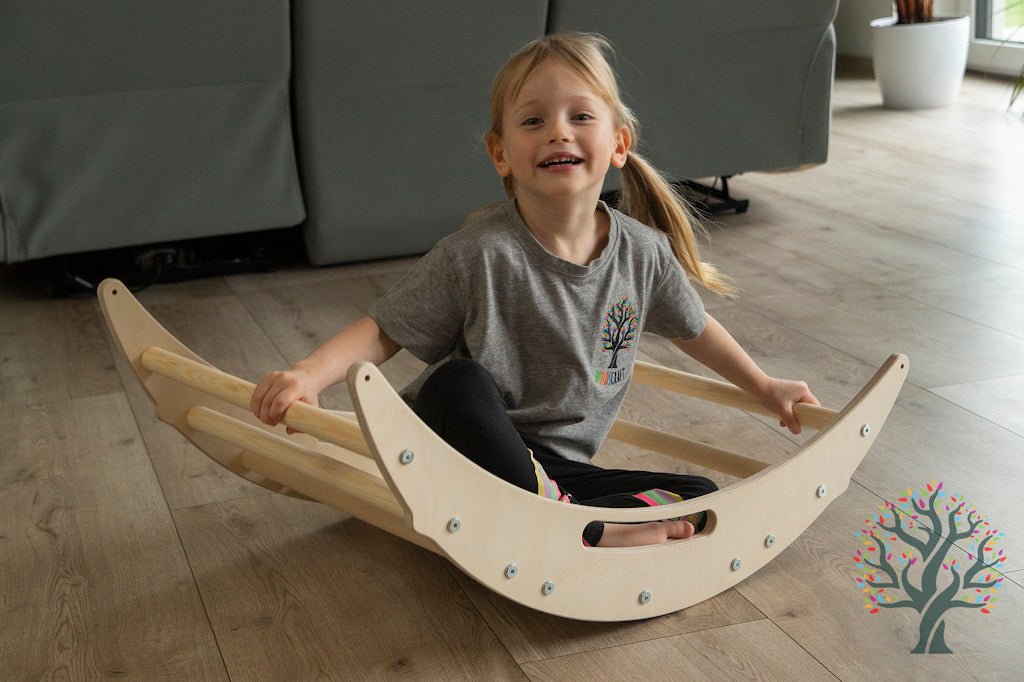

Kletterbogen INSPIRATION | Wippe & Kletterbogen (S) | inkl. Premium Kissen, optional mit Rutsche
From €99,00
Unit price perKletterbogen INSPIRATION | Wippe & Kletterbogen (S) | inkl. Premium Kissen, optional mit Rutsche
From €99,00
Unit price perVerwandle dein Zuhause in einen vielseitigen Bewegungsraum für dein Kind!
Die INSPIRATION Wippe & Kletterbogen (S) kombiniert Schaukelspaß und motorisches Training in einem kompakten Gerät. Ideal für Kinder von 1–3 Jahren (max. 50 kg), fördert es spielerisch Gleichgewicht, Muskelkraft, Koordination und Körpergefühl – perfekt zum Schaukeln, Klettern und Entspannen.
Highlights auf einen Blick
-
Wippe & Kletterbogen in einem Set
-
Premium-Auflage: Abnehmbar, waschbar und aus weicher Baumwolle
-
Hohe Sicherheit: Zusätzliche Stabilisatoren, CE-zertifiziert
-
Nachhaltige Materialien: 15 mm Multiplex Birke & Fichtenholz-Rundstäbe
-
Kompakt & flexibel: Ideal für kleine Räume und Sensorische Integrationstherapie
Produktdetails
| Komponente | Maße (L×B×H) | Material |
|---|---|---|
| Wippe / Kletterbogen (S) | 80×50×28 cm | 15 mm Multiplex Birke; Fichtenholz-Rundstäbe |
| Premium-Auflage | – | Weiche Baumwolle, abnehmbar & waschbar |
| Stabilisatoren | – | Zusätzliche Metallstreben |
So unterstützt das Set dein Kind
Motorische Fähigkeiten stärken
Fördert Gleichgewicht, Muskelaufbau und Koordination beim Schaukeln und Klettern.
Kreatives Spielen
Ermöglicht fantasievolle Spielwelten und kleine Bewegungsparcours.
Therapeutischer Nutzen
Ideal für Sensorische Integrationstherapie und gezieltes vestibuläres Training.
Sicherheit & Pflege
Nur unter Aufsicht verwenden. Zusätzliche Stabilisatoren vor der Nutzung anbringen. Holz vor Feuchtigkeit und direkter Sonneneinstrahlung schützen. Auflage bei 30 °C waschen.
Alter & Gewicht: 1–3 Jahre, bis 50 kg
Zertifizierung: CE-geprüft, umweltfreundlich gefertigt
Entdecke Kletterling
Kletterdreiecke sind nur der Start in eine bewegte Kindheit. Du findest bei uns Kindermöbel, Sprossenwände, Sitzsäcke, Sofas, Schaukeln und noch so viel mehr.

Familienunternehmen mit Herz
Persönlich beraten
Wir beraten dich persönlich in Entwicklungs- und Einrichtungsfragen bequem zu Hause. Schon ein paar leicht aufzustellende und sichere Bewegungselemente, wie ein Kletterdreieck, verändern die Auslastung deines Kindes und damit seine Stimmung zum Positiven. Doch das ist nur der Anfang, mit uns kannst du euer Zuhause in einen Ort verwandeln, in dem dein Kind jederzeit seinem Bedürfnis nach Bewegung und Entspannung nachgehen kann und dann passiert etwas Magisches, wie von Zauberhand zieht Gelassenheit bei euch ein, in deinem Kind und in dir!
Wir sind Isabell, Erik und Kosmo. Gegründet haben wir Kletterling aus der Not heraus: Qualität wird so oft mit Marketing-Blabla vorgetäuscht. Wir wollen so viel Transparenz, wie möglich ist. Aus welchem Material ist mein Kinderspielzeug, woher kommt es und wurden Chemikalien verwendet? Wie steht es um die Sicherheit und wird es wirklich in Europa produziert? In China produziert, in Deutschland zusammengebaut und dann Made in Germany, gibt es bei uns nicht. Alle Produkte stammen von kleinen Herstellern aus Europa, denen wir hier ihre verdiente Plattform bieten. Dabei hapert es meist am Kundendienst in einer fremden Sprache, den wir komplett übernehmen, weil wir es lieben, mit euch im Austausch zu stehen, was heutzutage leider immer seltener wird.
Außerdem kaufst du bei uns mit sicheren Zahlmethoden in Deutschland bei einem deutschen Unternehmen ein, was dir ein gutes Gefühl und Sicherheit bringt, damit du dich voll auf das konzentrieren kannst, weshalb du hier bist: Das richtige Bewegungsspielzeug für dein Kind zu finden.
Danke für dein Vertrauen!
- Isabell & Erik
Kategoriebeschreibung
Climbing arch: Promote your child's development through play
Climbing arches have become an indispensable part of the world of activity toys for children. These versatile play equipment not only promotes little ones' motor skills and creativity, but also offers hours of fun. In an age where screens often dominate our children's leisure time, climbing arches offer a welcome change of pace and encourage more active play.
But what makes a climbing arch so special, and how do you choose the right one for your child? This article introduces us to the world of these fascinating toys. We explain the benefits they offer, the different types available, and offer tips on what to look for when purchasing one. You'll be amazed at how versatile a climbing arch can be and how it can support your child's development through play.
What is a climbing arch?
 A climbing arch is a versatile activity toy specially designed for children to promote their motor skills, sense of balance, and creativity. Usually made of wood, it is characterized by its robustness and durability. The arch can be used as a seesaw, bridge, or as a classic climbing frame, making it an indispensable part of children's play.
A climbing arch is a versatile activity toy specially designed for children to promote their motor skills, sense of balance, and creativity. Usually made of wood, it is characterized by its robustness and durability. The arch can be used as a seesaw, bridge, or as a classic climbing frame, making it an indispensable part of children's play.
Climbing arches come in a variety of sizes and shapes, from simple models to those with integrated slides or cushions for added fun. Some models, such as theXXL Foldable Montessori Climbing Arch and Natural Climbing Seesaw , are foldable for easy storage. This flexible toy is suitable for both indoor and outdoor use and offers children ages 1 and up the opportunity to explore their physical abilities in a safe environment.
Using a climbing arch not only promotes a child's physical development through climbing and balancing, but also stimulates their imagination: Children can incorporate the arch into their games and transform it into various objects according to their imagination. Furthermore, the movements involved in playing with the arch help improve coordination.
Safety and naturalness are also important aspects in the manufacture of climbing arches. Most products are made of untreated wood without sharp edges or toxic varnishes, making them a healthy choice for play in children's rooms.
Whether you choose a simple wooden climbing arch or prefer a complete set with a slide and play mats , the right climbing arch is not only fun but also naturally supports your child's important developmental phases.
What wood is used for the climbing arch?
When choosing a climbing arch, it's important to know what material it's made of. Most climbing arches are made of high-quality wood, which is not only sturdy and durable, but also ensures your child's safety. The following types of wood are most commonly used for making climbing arches.
birch wood
Birch wood is one of the most popular materials for climbing arches. Not only is it strong and durable, but it also has a smooth surface that prevents splitting. The light wood also blends aesthetically into almost any environment, providing a natural look.
Beech wood
Beechwood is characterized by its high strength and hardness. It's ideal for toys that are regularly subjected to high levels of stress. The dense fiber structure of beechwood also makes it particularly durable and safe for children's hands.
oak wood
Oak wood is valued for its exceptional stability and durability. It's another preferred material for climbing arches, especially for outdoor use. Its resistance to moisture makes oak climbing arches ideal for outdoor use.
All of these types of wood not only guarantee the stability and durability of the climbing arch, but also contribute to creating a healthy environment free from harmful chemicals or varnishes. When choosing a climbing arch, you should ensure that the wood used is untreated or has been treated with non-toxic oils to ensure your child's safety.
In summary, this information about the different types of wood offers you the opportunity to make an informed choice - depending on whether the focus is on aesthetics, as with the birch and beech arches, or whether robustness is the priority, as with the oak climbing arches - always taking into account naturalness and safety aspects.
How long do children play with a climbing arch?
 Are you wondering how long your child can play with a climbing arch? A climbing arch isn't just a toy; it's a companion through your child's various developmental stages. Its versatility and adaptability to your child's growing abilities make it a long-lasting companion in the nursery.
Are you wondering how long your child can play with a climbing arch? A climbing arch isn't just a toy; it's a companion through your child's various developmental stages. Its versatility and adaptability to your child's growing abilities make it a long-lasting companion in the nursery.
A climbing arch for babies 1 year and older promotes basic motor skills. At this age, it primarily serves as support for pulling themselves up and balancing. As a climbing arch for toddlers, it becomes a challenge for climbing, crawling, and sliding. Over time, children discover the possibilities of using the arch as a seesaw or in combination with other activity toys such as a balance board for children , mats, or cushion sets.
The age range for a wooden climbing arch is therefore approximately 1 to 6 years, depending on the child's individual developmental stage and interests. However, there are also reports from parents and educators that older children find creative ways to incorporate the arch into their play – whether as part of an obstacle course or even as a cozy reading corner with cushions.
Thanks to its robust construction made of high-quality woods such as birch or beech, the climbing arch promises a long service life and safety for many years. This underscores the importance of choosing a product made from natural materials without toxic varnishes.
Overall, a climbing arch is much more than just a temporary play device. It provides a platform for physical development, encourages creative play opportunities, and adapts flexibly to the growing child. A high-quality product can thus be a central part of a child's play repertoire for years to come, promoting important motor and social-emotional skills.
Why is a climbing arch good for my child's development?
A climbing arch significantly supports your child's motor skills and physical development. Climbing, balancing, and exploring playfully promote gross and fine motor skills. The challenge of climbing the arch also builds your child's self-confidence and independence.
With a wooden climbing arch, your toddler benefits from the solidity of natural materials. Wood is a robust and durable material that guarantees safety during play. A climbing arch with a slide or a cushion offer additional fun and variety during play and contribute to creative development.
From the age of 1, children can gain their first experiences in the world of movement with a baby climbing arch . This early form of movement encouragement lays the foundation for healthy physical development. Whether for indoors or outdoors, the climbing arch for children adapts to their growing needs thanks to its versatile uses.
With products like the foldable climbing triangle or the Pikler triangle as a complement to the climbing arch, a varied activity course is created that trains not only motor skills but also social skills. Playing together promotes communication and interaction among peers.
Investing in a high-quality wooden climbing arch pays off in several ways: It accompanies your child through various developmental phases, supports harmonious motor development as well as social-emotional skills, and its sturdy construction ensures long-lasting enjoyment of play.
At what age / when do children use a climbing arch?
 When it comes to the question of when your child can start using a climbing arch, it's important to know that most children can safely play with a baby climbing arch under supervision from the age of 1. This toy not only promotes your child's motor skills and self-confidence, but also supports their physical development during a very important phase.
When it comes to the question of when your child can start using a climbing arch, it's important to know that most children can safely play with a baby climbing arch under supervision from the age of 1. This toy not only promotes your child's motor skills and self-confidence, but also supports their physical development during a very important phase.
When choosing a suitable climbing arch for toddlers, you should make sure it is sturdy and made of high-quality wood. A wooden climbing arch, thanks to its robustness and natural appearance, provides a safe environment for your child's playful development. Models such as the climbing arch with a slide or the climbing arch with a seesaw have the advantage of offering additional play options and keeping your child interested longer.
Models like the Baby Climbing Arch, which was specially designed for the needs of even the smallest climbers, are particularly suitable for toddlers. Rounded corners and a sturdy construction ensure your child can climb, slide, or swing safely.
Once your child starts walking or pulling themselves up, you can add a simple climbing arch. Over time, and as they grow older, your child will want to explore more complex structures. With products like an expandable Pikler triangle set, often combined with a climbing arch, you can adapt your child's play environment to their growing abilities.
In summary, climbing arches are ideal for indoor use from your child's first year onward, and for supervised outdoor use. Always consider safety aspects when selecting a product and choose a product made from natural materials like wood. This way, you'll provide your child with a safe foundation for playing and learning. Conclusion
A climbing arch is more than just a toy; it's an investment in a child's future. With its ability to strengthen motor skills and encourage creativity and self-confidence, it offers invaluable value for children's development. Choosing the right material not only guarantees safety and durability but also supports their natural joy of play. Whether indoors or outdoors, a high-quality climbing arch adapts to children's growing needs and remains a loyal companion through the various stages of development. After all, the joy of discovery and play is the foundation for healthy development. A climbing arch is therefore a worthwhile investment that goes far beyond mere play.
Frequently Asked Questions
 What are the advantages of a climbing arch for children?
What are the advantages of a climbing arch for children?
A climbing arch promotes children's motor skills, creativity, and independence. It's not only fun but also promotes physical development and coordination.
What type of wood should a climbing arch preferably be made of?
A climbing arch should preferably be made of robust and natural woods such as birch, beech or oak to ensure longevity, stability and safety.
Why are natural materials important for climbing arches?
Natural materials like wood guarantee safe play and support children's healthy physical development. They also encourage creative development through natural textures and structures.
From what age are climbing arches suitable for children?
Climbing arches are suitable for children ages 1 and up. They support physical development and strengthen children's motor skills from an early age.
How do I choose the right climbing arch?
When choosing a climbing frame, consider the quality of the wood, its stability, and safety features such as rounded corners. Models with additional play options will keep children engaged longer.
Are climbing arches also suitable for outdoor use?
Yes, climbing arches are suitable for both indoor and outdoor use, as long as they are used under supervision and in a safe environment. The material should be weather-resistant.
What is a Pikler triangle and how does it complement the climbing arch?
A Pikler triangle is an expandable climbing toy that, when combined with a climbing arch, allows for adaptation to the child's growing abilities. It promotes physical activity and independence.
Our customer service team is happy to answer any questions you may have and help you choose the right climbing frame. Our climbing arches also comply with the requirements of the EU Toy Safety Regulation EN 71. For example, the rung spacing and diameters are standardized to ensure maximum safety. We ship within 24 hours, and you'll receive free replacement parts delivered to your door.
At Kletterling, you'll find not only high-quality toys but also a large selection of high-quality furniture for children's rooms. A children's wardrobe or a children's bookshelf will create order and encourage your child's independence. For the garden, you'll also find a climbing frame or a mud kitchen .
Discover more in: Play & Climb
Top categories: Climbing triangles | Climbing triangle with slide | Climbing triangle set | Climbing frame | Climbing wall | Slides



